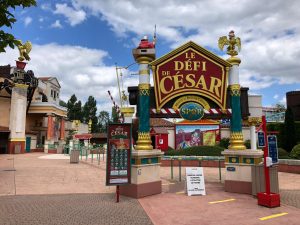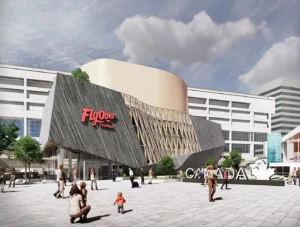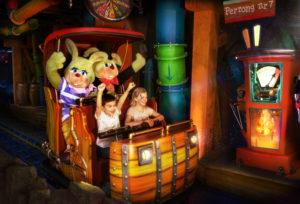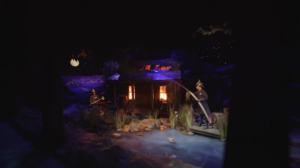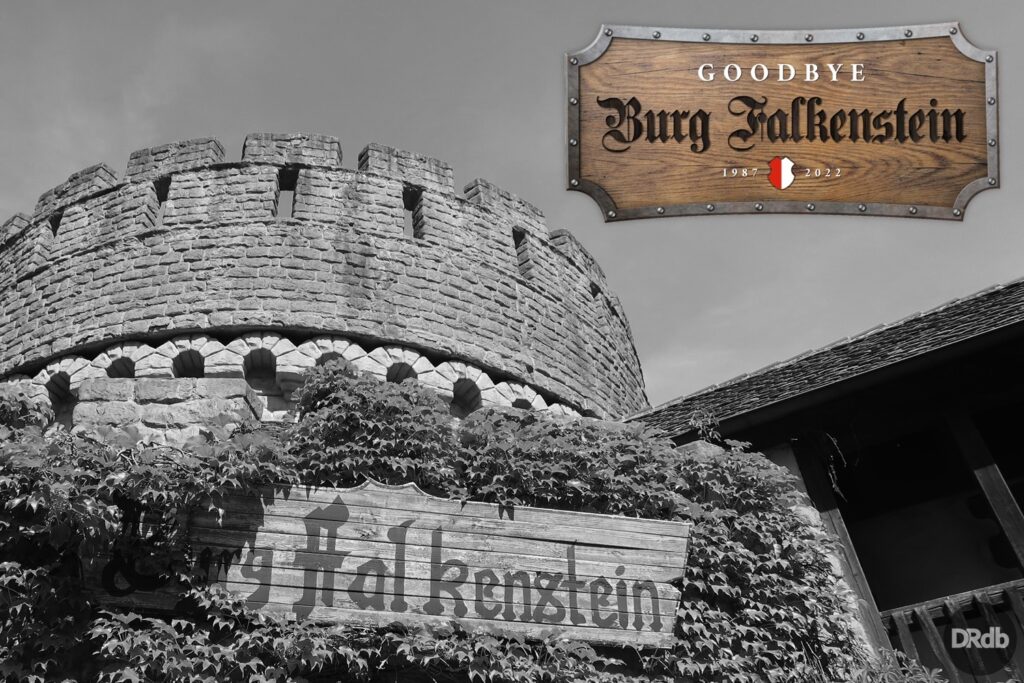
It has not been a secret that the classic dark ride Burg Falkenstein at Holiday Park (Germany) would one day be making way for something new. Ever since Plopsa Group bought the park in 2010 they have gradually been transforming the property into one of their flagship parks where both families and thrill seekers can find what they’re looking for. Burg Falkenstein was one of the rides custom designed to draw the family demographic.
Until 2010, Holiday Park was owned by the Schneider family, who had their own vision on the way to operate a theme park: they never built just some ride, it had to be something special each and every time. Following that philosophy, the park constructed amongst others Teufelsfässer, the world’s first log flume with a backwards drop, and Expedition GeForce, often regarded as the best steel roller coaster in the world. The park included a number of such large, innovative rides, which was quite remarkable for an independently owned, small German park, especially considering its location in the vicinity of Germany’s largest theme park, Europa-Park.
Burg Falkenstein similarly was a response to competing parks who during the early and mid 80s were adding large scale dark rides. Where most went for a haunted house or pirates themed ride, often inspired by Disney, Holiday Park wanted to create something unique and opted for a dark ride based on a Medieval castle.
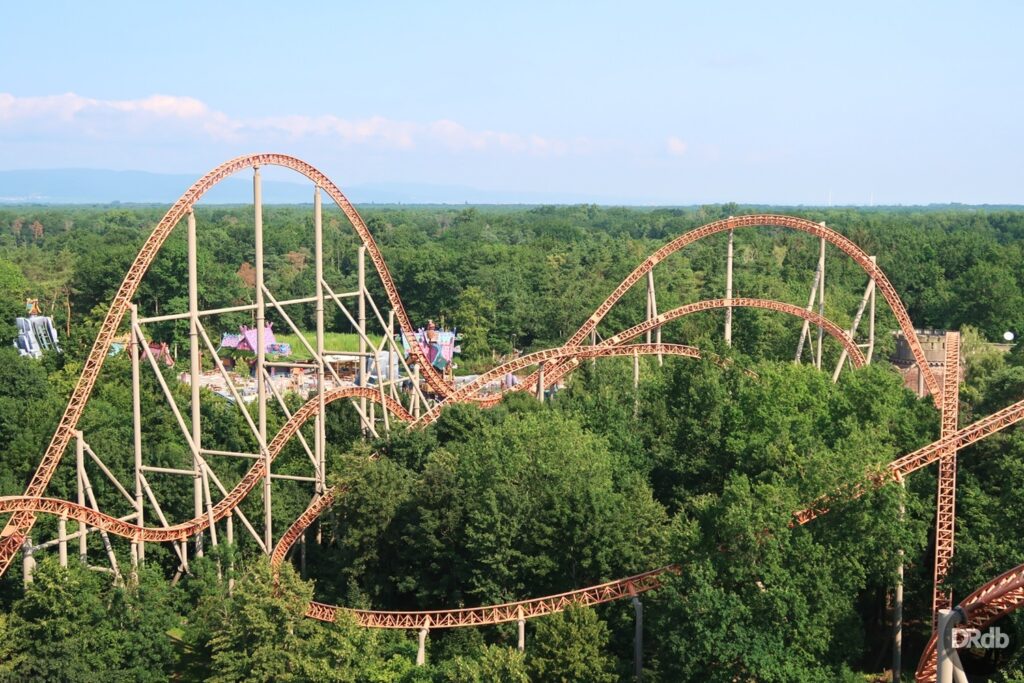
After over 25 years of successfully running Holiday Park, during the late 90s, the Schneiders were thinking of selling the park in order to enjoy a wealthy retirement. 2001’s Expedition GeForce was quite the investment, meant as somewhat of a swansong for the Schneiders and to attract potential buyers. While maybe it took longer than expected, they eventually found a buyer in the Plopsa Group in 2010.
While the acquisition initially didn’t mean much in terms of how the park was run, slowly but surely areas started to get revamped. Even though the park hardly seemed to conduct any maintenance to Burg Falkenstein, it would take 12 years until the ride was eventually closed for a retheme by the end of the 2022 season. In 2024, the ride will reopen, themed to the Smurfs.
Index:
– Goodbye Burg Falkenstein
– A walk through the castle
– Going backstage
– The future of Burg Falkenstein
Goodbye Burg Falkenstein
When Holiday Park announced they would be closing Burg Falkenstein a short while ago, they also announced the plans they had for a special goodbye ceremony. The park organised an auction, in which fans would get the chance to bid on about 120 items from the ride, as well as a one of a kind backstage tour. Team DRdb didn’t hesitate to sign up. Join us on this adventure ”hinter den Kulissen”!
On Saturday 5 November, we drove to the village of Haßloch and parked in style in the Burg Falkenstein Straße of the parking lot. Most of the park was closed, as it was off-season, but some sections like Holiday Indoor were open for the general public. That was however not where we were heading: for the tour, a special waiting area was created on the main square behind the entrance.
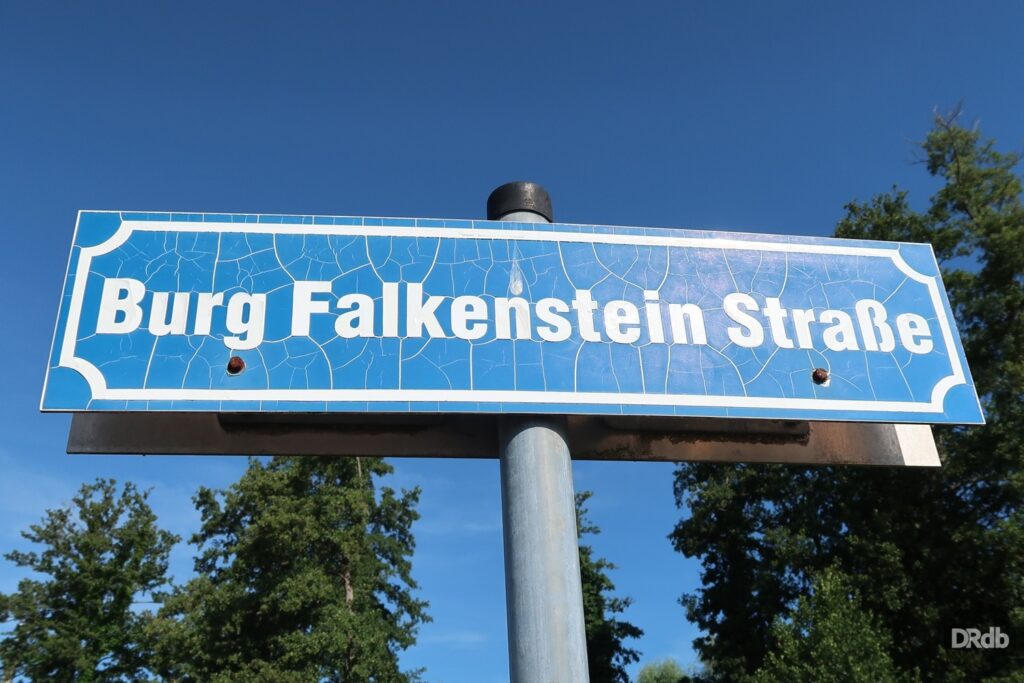
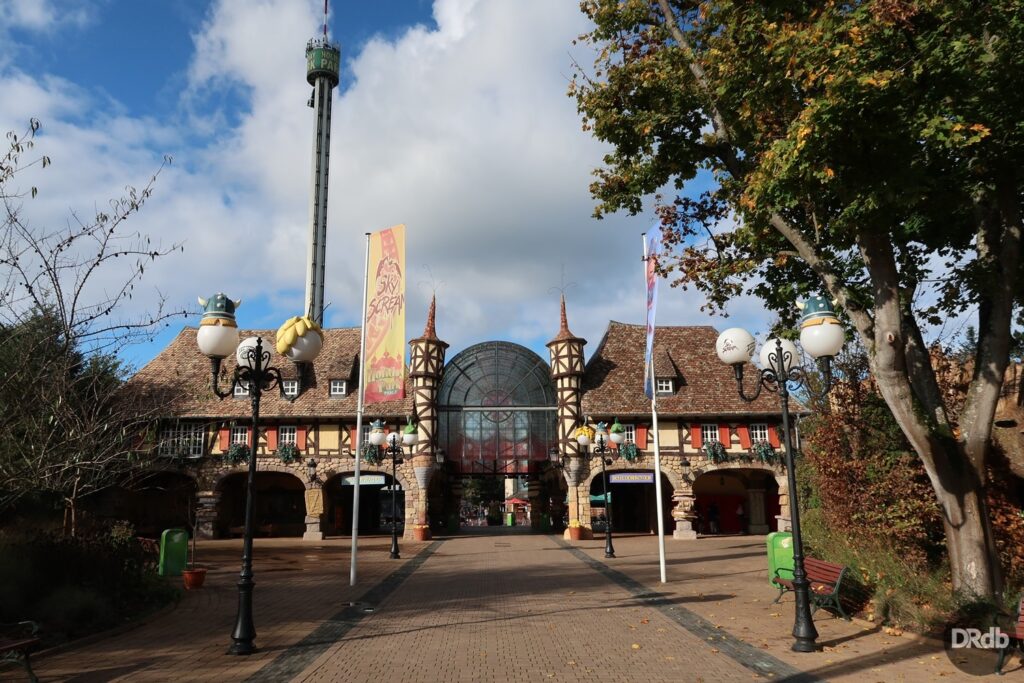
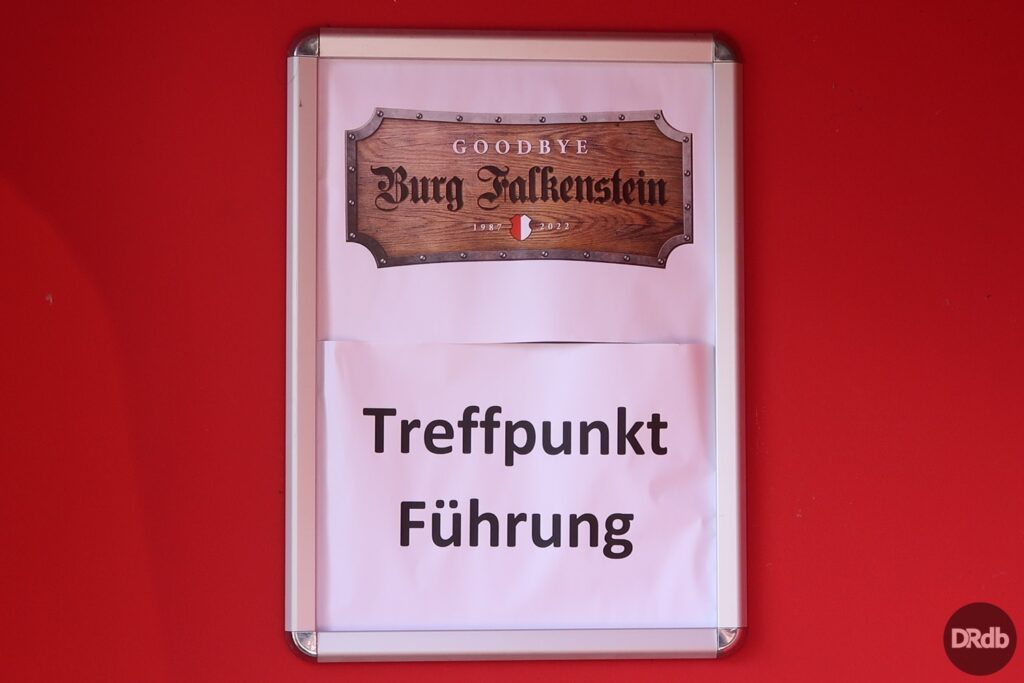
A total of 200 fans of Burg Falkenstein showed up for the tour, divided into groups of about 10 per time slot. Every half hour, a guide would come pick up the next group and lead them towards the castle, located further back in the otherwise closed park. On the way there, music and sound effects from the ride could be heard coming from speakers, a nice touch to get in the mood.

After a walk, we ended up in front of the castle, looking a lot less appealing devoid of any greenery like it usually would be during the summer season. Our guide conjures up a pile of paperwork. House rules? No, we were being read the original press release from 1987, filled with statistics and facts on its creation. It is almost as if we’re witnessing the ride’s opening, as we hear how it all came to be as if it were yesterday.

We learn that the ride was the brainchild of Wolfgang Schneider. The Schneider family took over a small fairy tale park in 1970 and quickly transformed it into a fully developed theme park. One of the first heavily themed rides was outdoor boat ride Anno Tobak, inspired by the Middle Ages, which opened in 1974. Themes like these gave the park a more down to earth and mysterious tone compared to most contemporaries.
Burg Falkenstein would also be inspired by the Medieval era, but this time it would be a large scale dark ride. The attraction resembled a castle under attack, presenting a slice of life like how it was during the 12th and 13th century. While partially educational with its historically accurate knights, torture chamber and impressive knight’s hall, the adventure would be topped off with an encounter with an enormous dragon guarding a treasure.
Schneider enlisted the help of set designer Andreas Heller to design the interior and exterior, which took them about one year. By cleverly using two floors, the ride was fit in a rather small plot. Heller had been quoted saying: ”We had to familiarise ourselves very thoroughly with the literature of the time, especially with the history of the Pfalz (Palatinate region). Burg Falkenstein is a very complicated building, in which a perfect balance has been struck between visual and technical qualities.”
The Burg (‘castle’ in German) thanks its name to (and was at one point even sponsored by) the real life ruins of Burg Falkenstein in the village of Falkenstein, located about an hour’s drive away from the park.
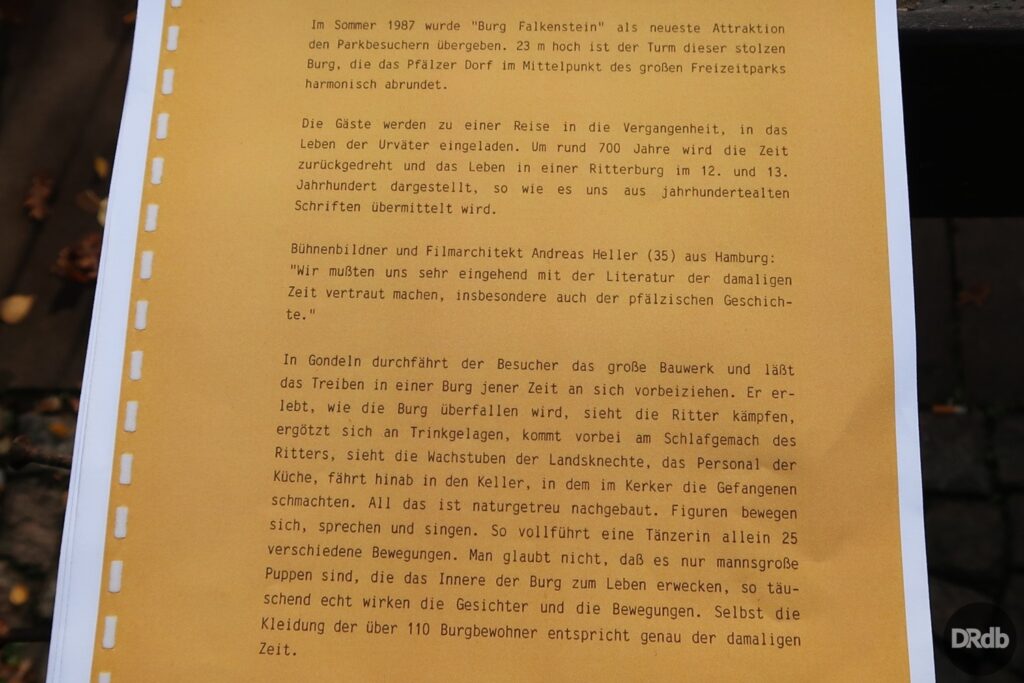
The construction of the castle took another year, for which 406 m3 of concrete and 327 m3 of stone was needed. The outside was loosely inspired by Burg Neuleiningen in the village of Neuleiningen. It was modelled by the German firm Böhm & Partner, the same company that worked on many big theme park and dark ride projects of the time period such as Efteling’s Fata Morgana.
The decors for the interior were manufactured by the renowned Studio Hamburg, known for their work on various German television series, and shipped to be installed at the castle afterwards. The realisation of the 110 animatronic inhabitants was outsourced to Hofmann Figuren. Their true to life clothing and accessories were however also produced by Studio Hamburg.
Lastly, an Omnimover system of 160 metres in length was installed by the German manufacturer Mack Rides. It is the same system, down to the shape of the gondolas, as Europa-Park’s Geisterschloss, which opened in 1982. All in all, Burg Falkenstein would end up costing over 7 million DM (over 2 million more than originally envisioned), which amounts to roughly €6,6 million in today’s money.
A walk through the castle
Once the informative introductory speech had come to an end, the tour through the castle could begin. A few historical attributes were displayed near the ride’s entrance. A series of picture frames depict cut-outs from the amazingly detailed promotional artwork and were used to brighten up the construction fences during the 1986 season. The artwork itself even served as inspiration for the decorators. German board game manufacturer Schmidt Spiele was also impressed with the piece, and gained permission of Holiday Park to use it on the box for one of their releases: Das Fest der Schwertmeister (The Sword Masters’ Feast), an expansion set for the role playing game Das Schwarze Auge (The Dark Eye).
Also displayed was the original sign that used to adorn the entrance facade, which was quickly replaced with a larger one, to better catch the eye of visitors.
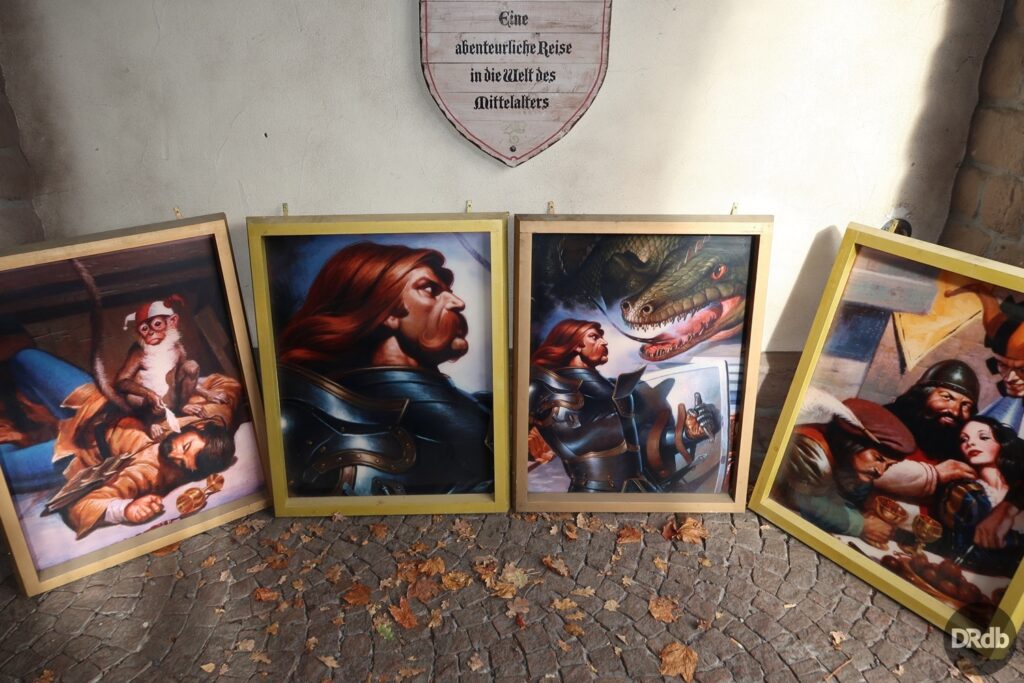
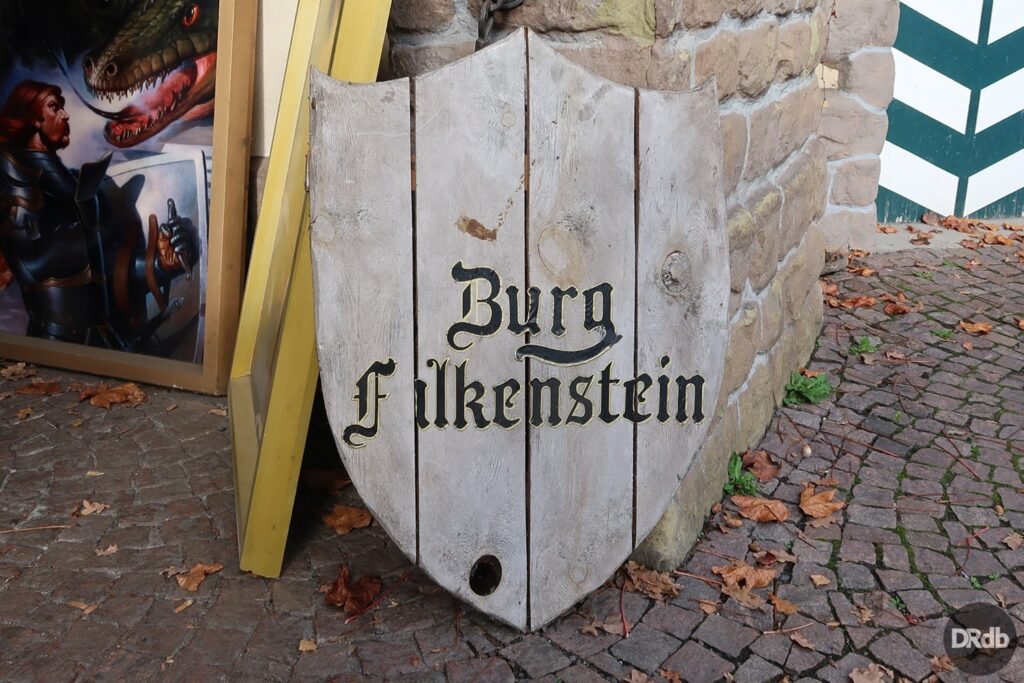
Overlooking the group about to enter the castle was Jan-Philipp Reinisch of the marketing department. He noticed we were struggling to understand the German guide, and was kind enough to take us on a private tour in English. We went inside through an emergency exit in the tower to the left of the castle. Behind it lies a spiralling staircase upwards. ”Because the burg has never been evacuated in its 35 years of operation, we had to do a lot of cleaning here earlier today”, explains Jan-Philipp while leading the way. He has been working in Holiday Park since 2015 and knows Burg Falkenstein inside and out.
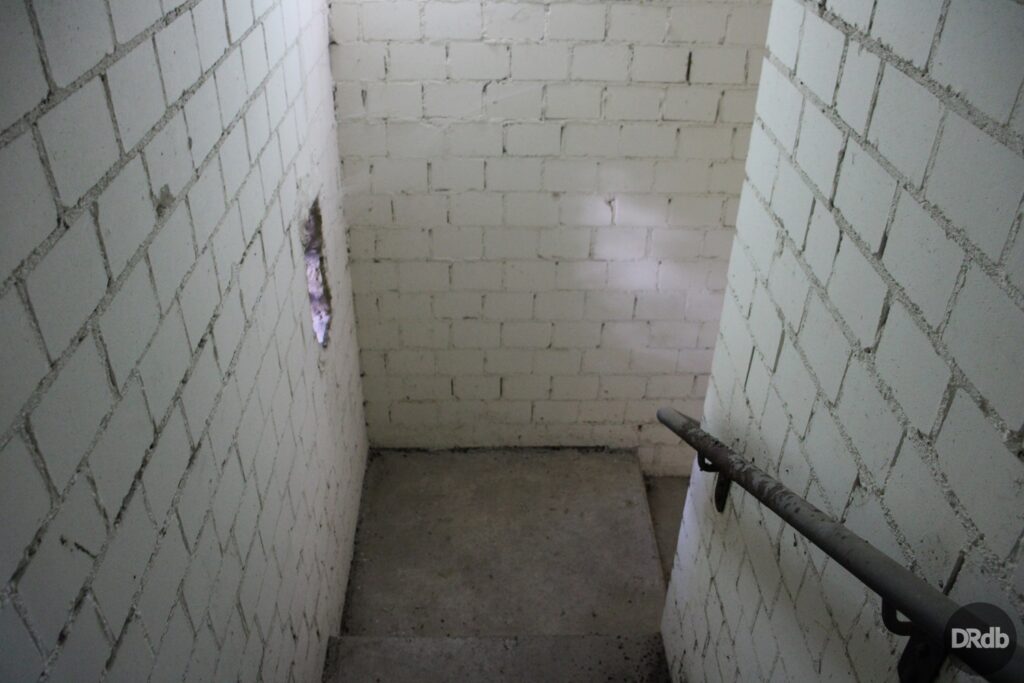
A balcony leads towards the first scene on the top floor, the one in which the castle is being attacked by archers wielding flaming arrows. The moody lighting we associate with the ride was nowhere to be seen today, instead everything was brightly lit with work lights. Still, the theming is impressively immersive as all rooms are decorated a full 360°.
The recognisable, short voice clips that could normally be heard being endlessly repeated (”Sie schießen mit Brandpfeilen, die Mauer stürzt ein! Alarm!”) had been exchanged for dead silence, except for some faint clicking of the valves inside the animatronics, which remained motionless. We took some time to appreciate the detailed work that went into the decor.
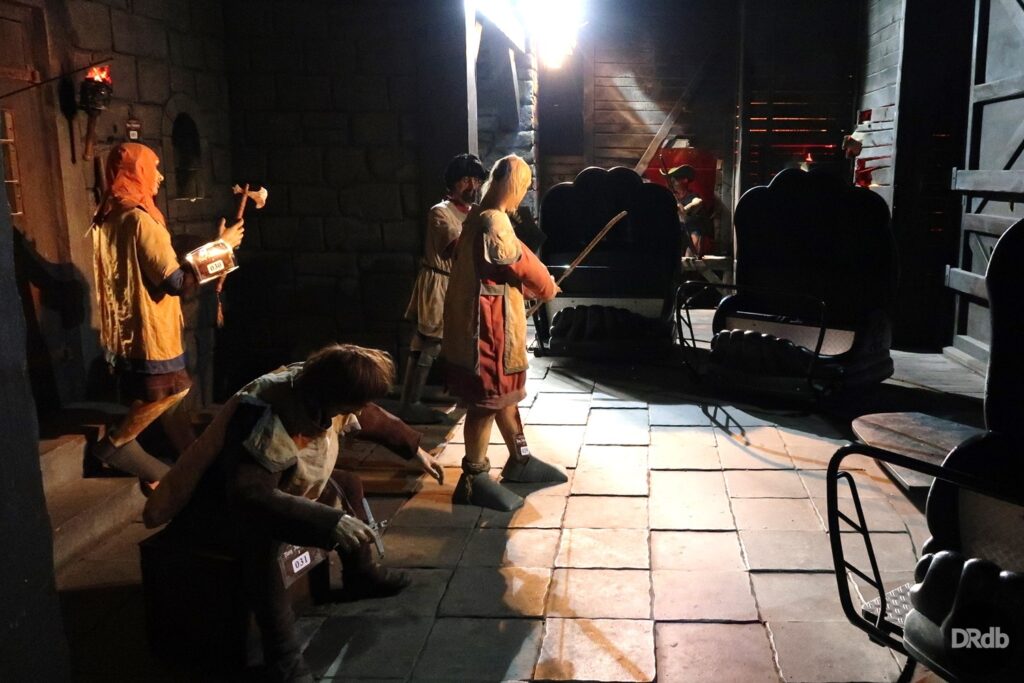
Jan-Philipp led us to the opposite side of the scene, where the backs of the gondolas are turned towards, to show us one of his favourite details. ”This wall would originally fall forward a bit, as if it was collapsing. But because barely anyone noticed it, the effect was never repaired when it broke.” He proceeded to show us an intricate system of piping and fog machines hidden behind the wooden walls, which used to simulate smoke coming from the fire caused by the arrows. The smoke systems probably haven’t been used for decades.
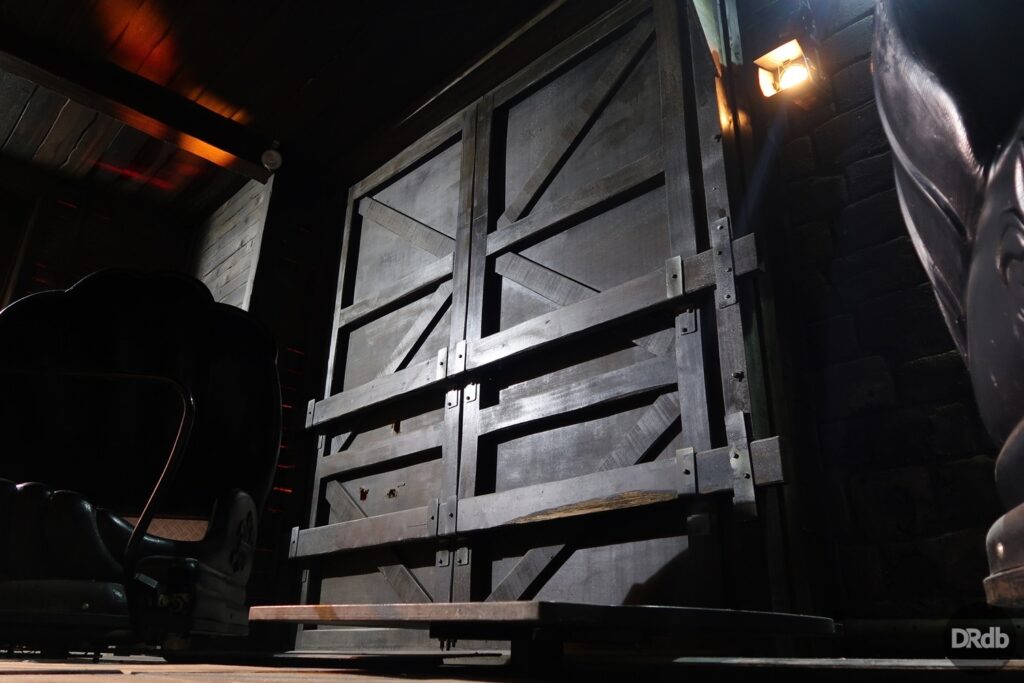
In a corner stands one of the attackers, a bow and arrow ready to fire in his hands. Next to him, battering rams can be seen coming through the wooden walls, the planks of which would appear to be splitting apart when the ram was drilling its way through. We were able to take a look behind the wall and see how the effect was pulled off: the ram is attached to a cart on wheels and a pneumatic cylinder pushes it toward the wall, causing springs to loosen and the planks to fall forward.
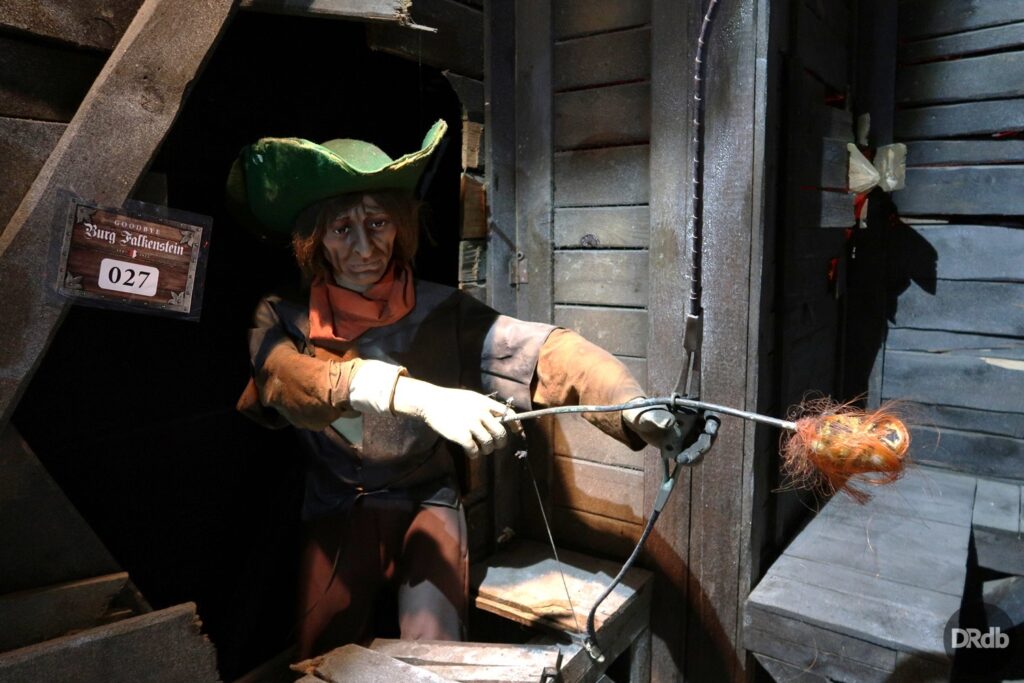

Continuing onto the next scene, we arrived at the most notorious and likely most photographed one. A bedchamber in which a couple has just been awoken because of a flaming arrow that flew inside. The damsel has already got out of bed and is holding the bed sheets up in front of her body. The knight, tangled up in the bed sheets, tries to stand up but instead pulls the sheets away from the lady, making her expose herself.
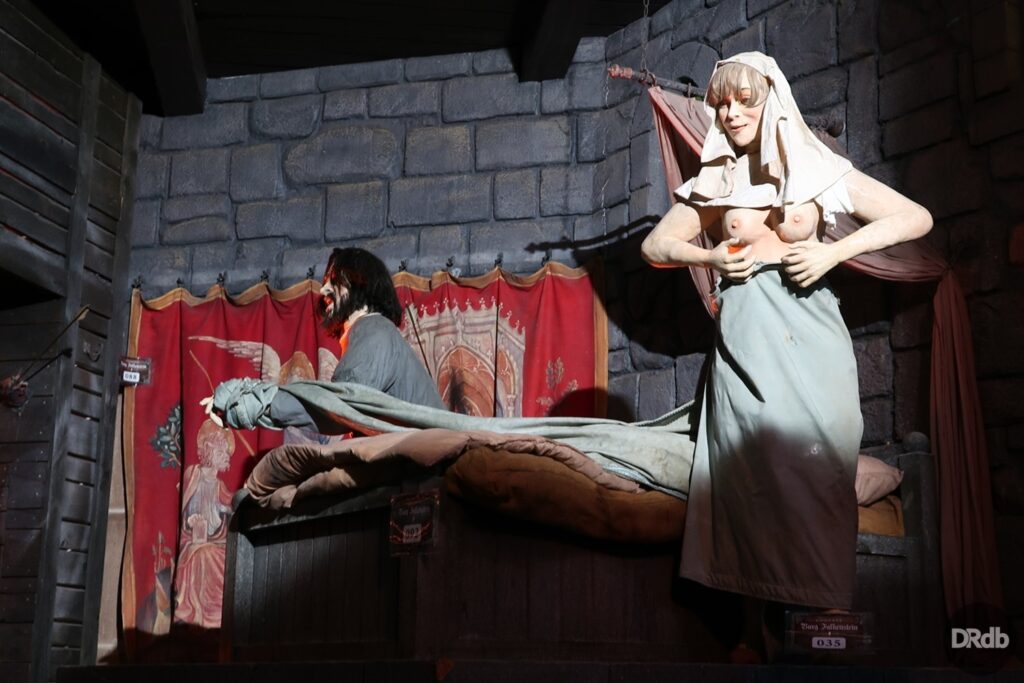
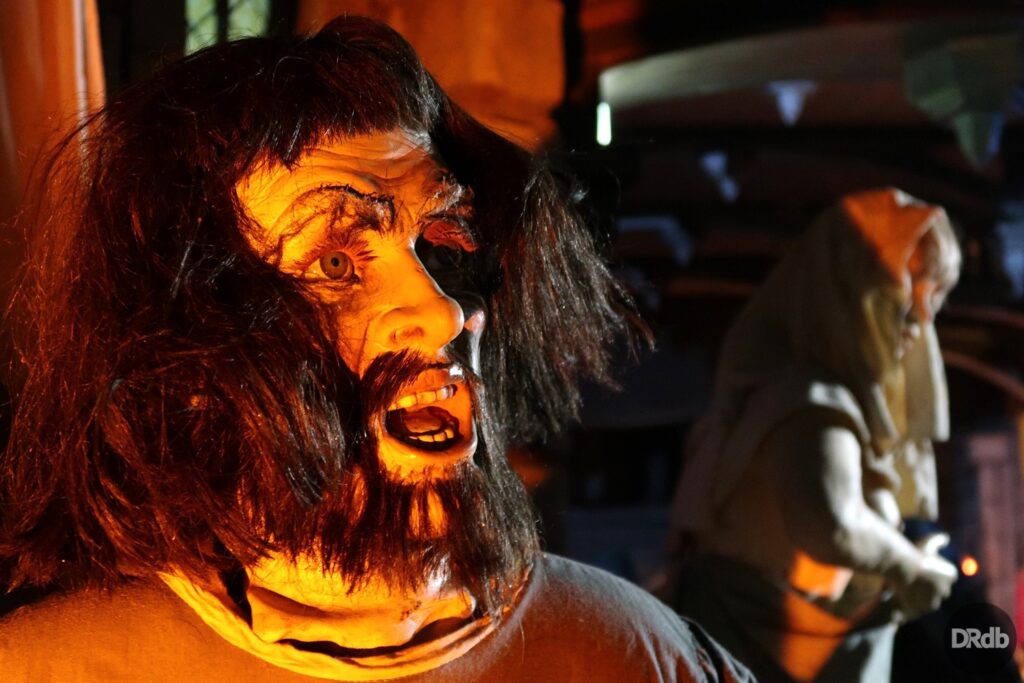
Hidden behind a hatch in the wall we found a small technical room with a bunch of control cabinets inside. They control the flickering of the lights in the flaming arrows and torches found throughout the burg. Each light on the front of the cards corresponds with one of the fire effects and they can be programmed individually.
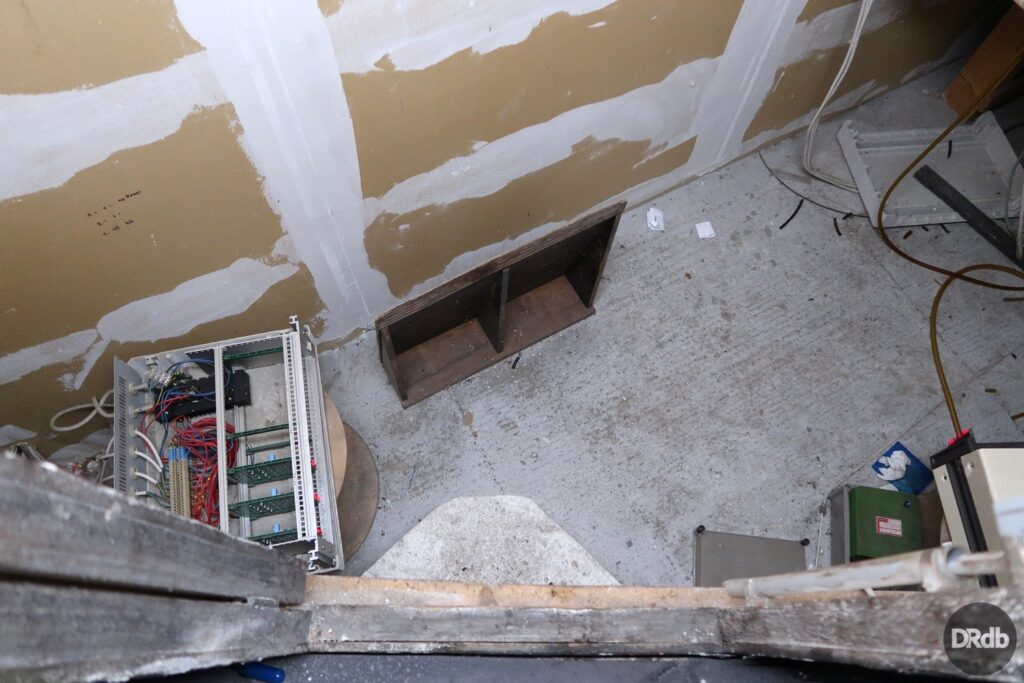
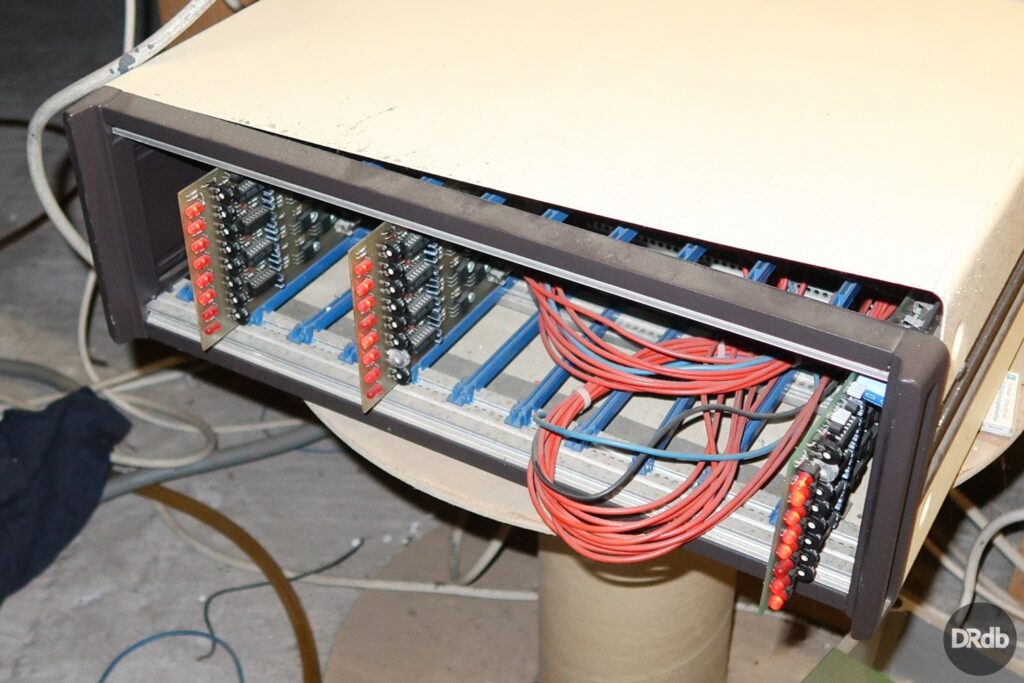
It was busy in the scene ahead so instead we turned around and made our way backwards through the castle, towards the scene with the pub. Here we found the motionless cook outside, still holding onto the lady he was trying to drag home with him. We were able to take a peek ”inside” the pub and find out that the drunken monk behind the window does not have a lower body, as it would never have been seen by anyone anyway.
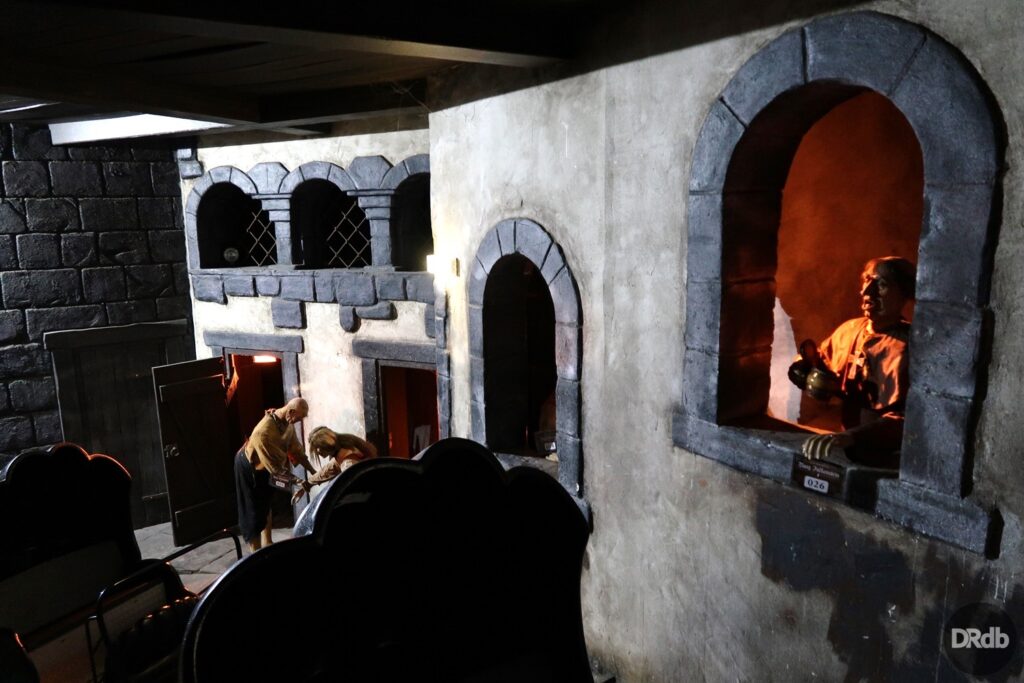
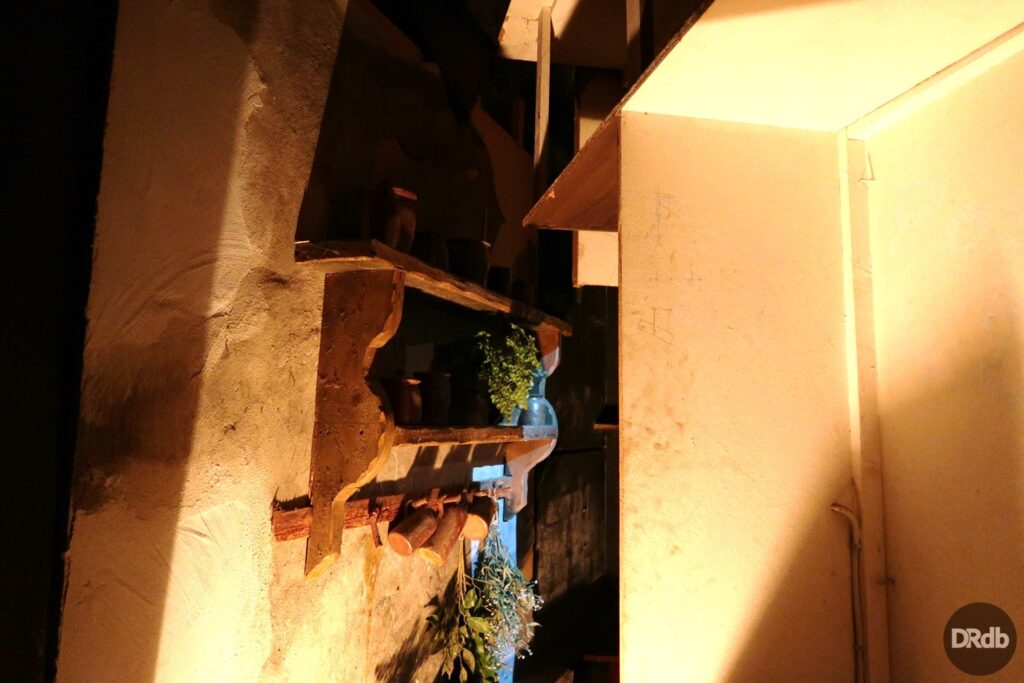
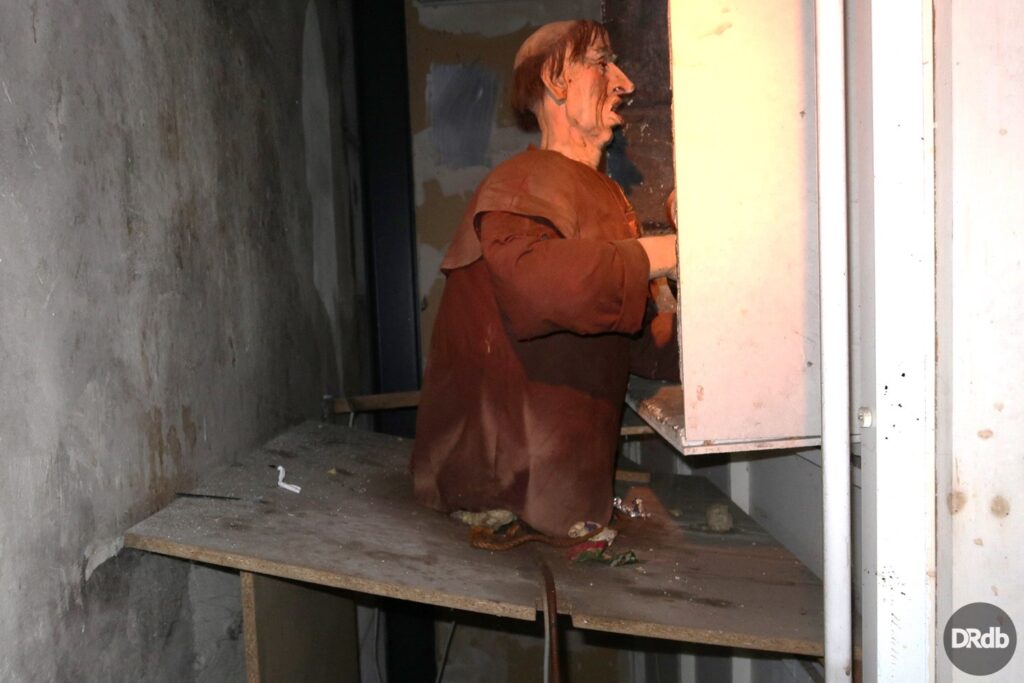
We continued further down and ended up in the (finally somewhat lit up) torture chamber, the 3rd scene. It is one of the more gruesome scenes, especially the prisoners stuck in the well must have been an intense sight back in ’87. It doesn’t help that some of the figures appear to be very nasty. ”That is a fire-proof coating that was applied wrongly”, explains Jan-Philipp. ”They were supposed to clean the animatronics and apply it annually, but one time they forgot to clean them, which means all the dust and dirt reacted with the chemicals.”
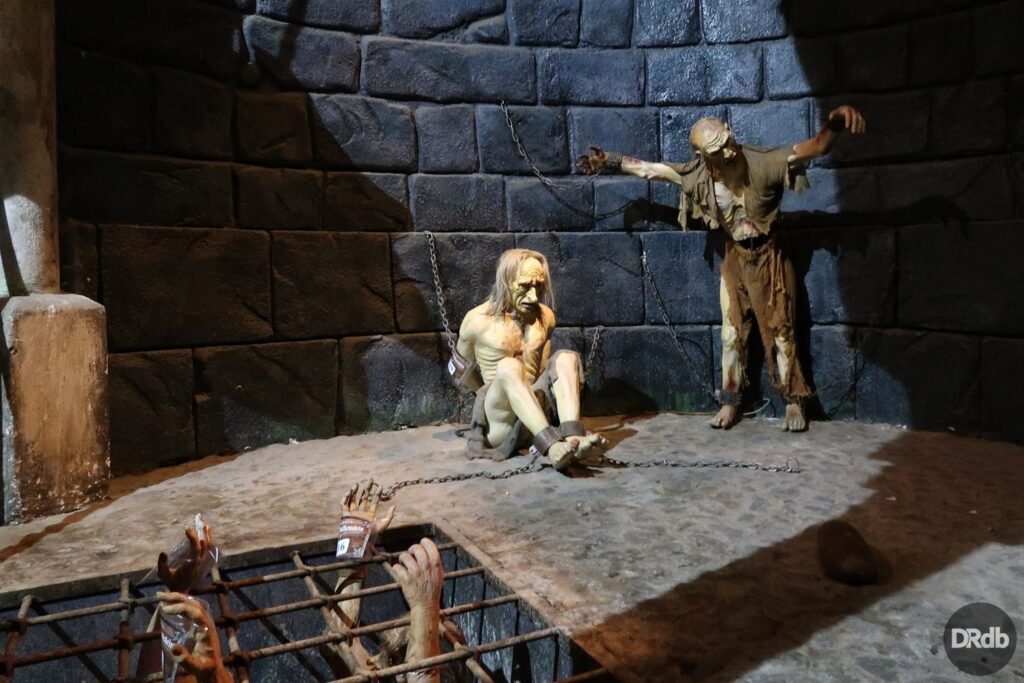
”There was also a rat sitting there, up until about a week ago. I guess one of our technicians took it as a souvenir.”
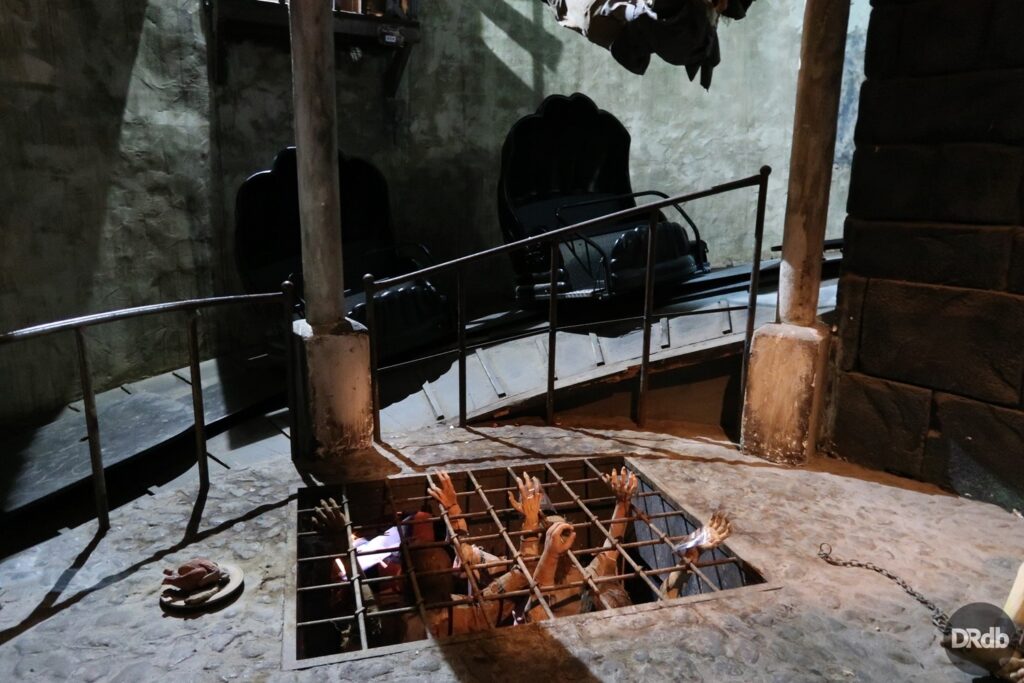
Continuing on, we found ourselves at a forge, where prisoners get their hands cuffed with glowing hot chains by the blacksmith. The scene is very detailed with a fireplace and various knight equipment like armour and shields in the background. A cage hanging from the ceiling contains another two prisoners, not yet cuffed.
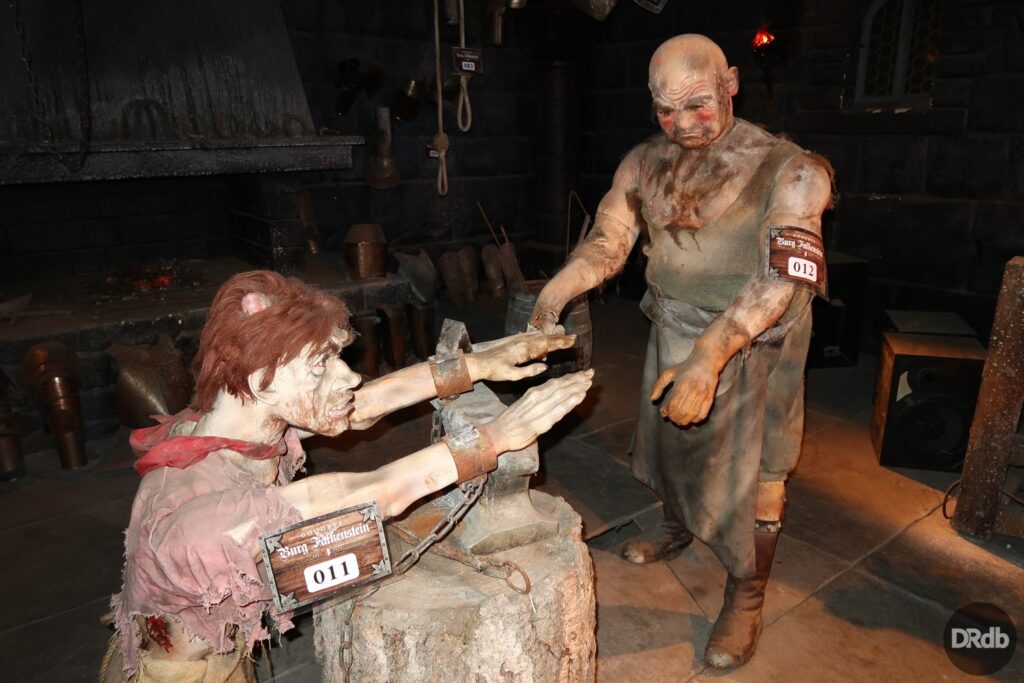
Jan-Philipp points out that the head of the blacksmith is made from the same mould as the cook we saw before. ”Making such moulds is expensive, so they opted to reuse as many of them as possible.” When standing in the back of the scene, it gives a whole new perspective. A door normally hidden out of view, actually leads towards the chamber we just got out from, proving just how cleverly the castle was designed.
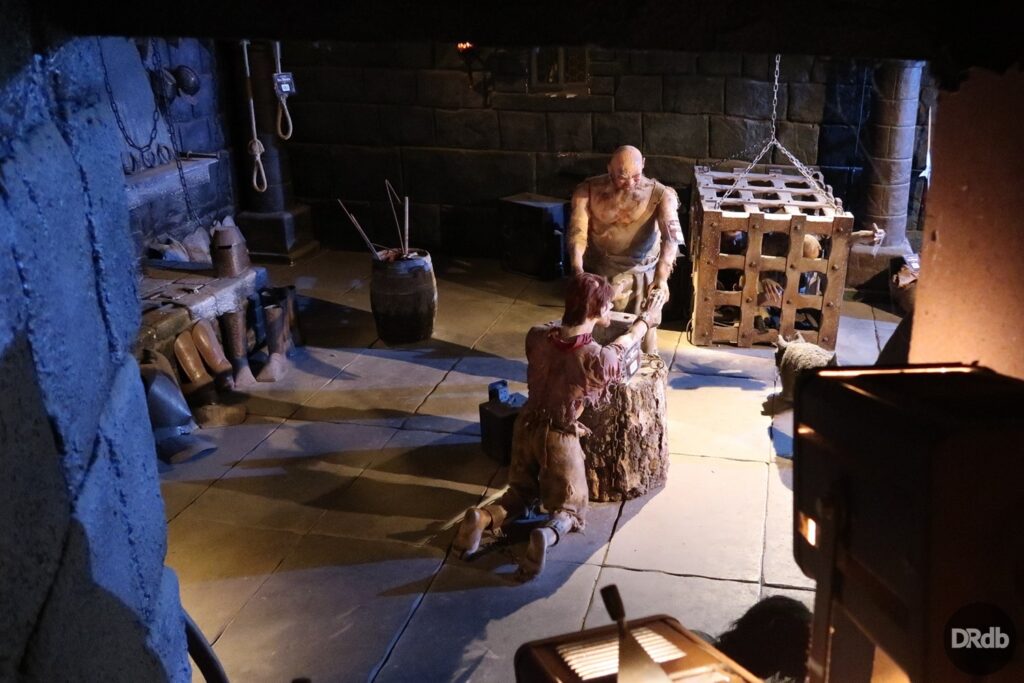
We took a break and quickly stepped outside through an emergency exit for a breath of fresh air. We were now looking at the rear side of the burg, which can’t be seen from inside the park. In fact, hiding right behind the bushes is the old family home of the Schneiders. Jan-Philipp is quick to point out the satellite dish attached to the roof of the castle. ”When the burg was finished, the Schneiders found out they couldn’t watch television anymore. The satellite dish was located in their garden and now the building was blocking the signal. Luckily they were able to move it up there.”

Back inside, the path led us to what normally would be the first scene, which explains how the castle is being attacked. On the right, a lady is singing for the knights of Burg Falkenstein, thus distracting them and giving the attackers the opportunity to sneak in. On the left, one of the attackers is faced towards the gondolas, his index finger resting on his mouth. ”Pssst! Pssst!”, can be heard, coming through the speaker in his belly. They’re climbing the outer wall of the castle with a ladder.
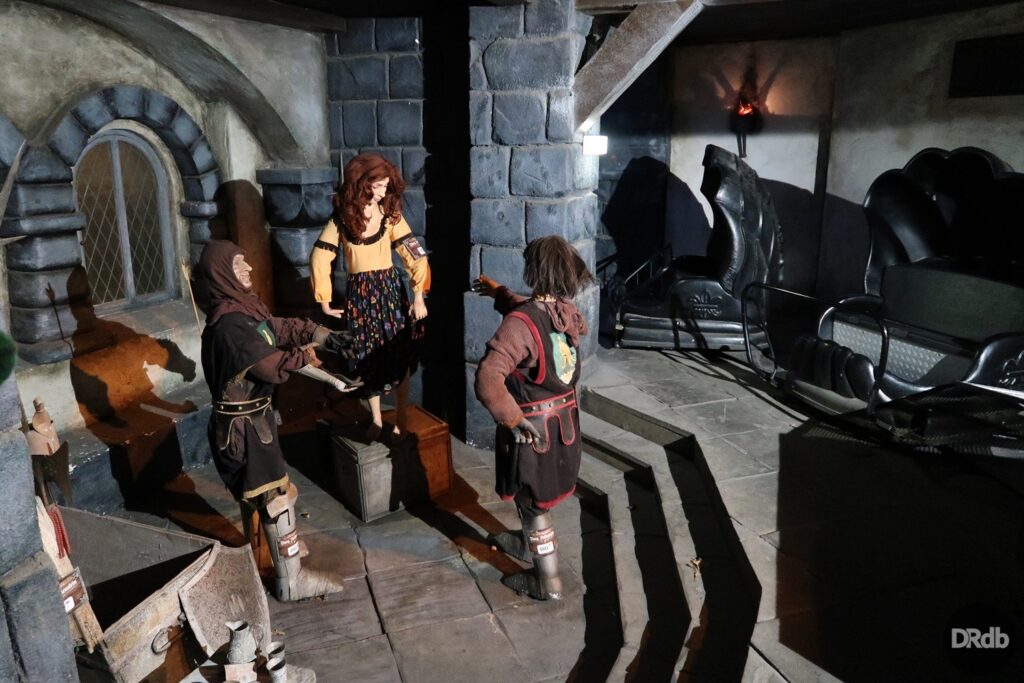
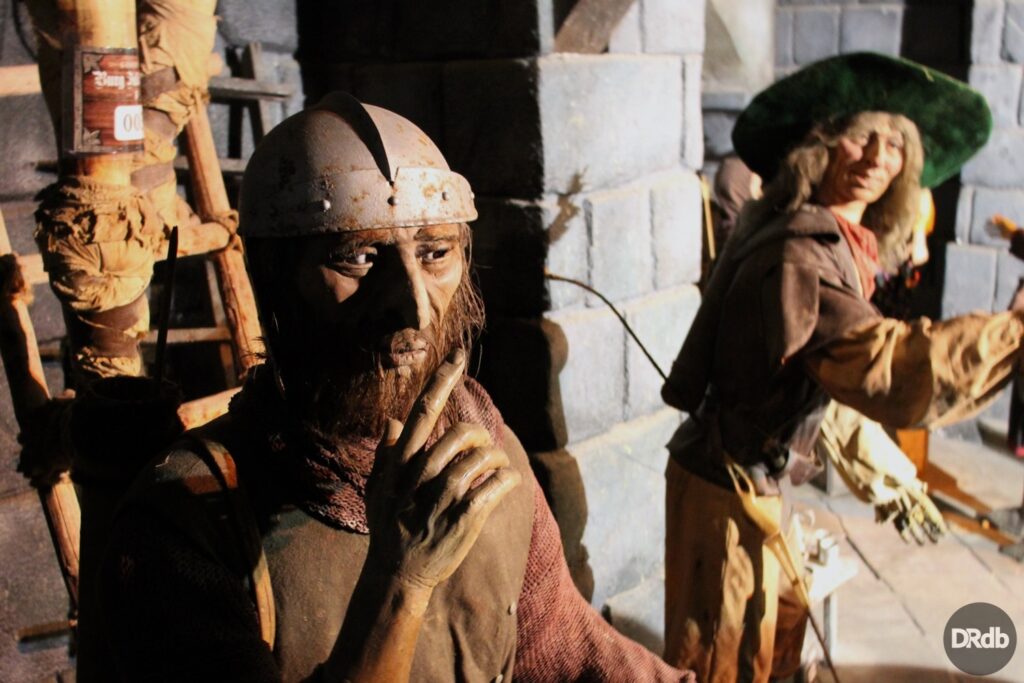
Arriving in the station, which is largely taken up by a turntable which runs at the same speed as the gondolas moving around it, Jan-Philipp explained the system installed that guarantees safe departures. Where the turntable ends and the decor begins, a steel fence is located. In case someone doesn’t board the gondola in time and bumps the fence, a sensor picks up on the motion and automatically activates the emergency stop. A safety spiel, voiced by Schneider himself, would then play asking guests to stay seated calmly.

The operator stands on the turntable at all times and has access to a control panel to manually stop the ride in case needed. A monitor showing live images of 8 surveillance cameras is also present. ”We’re going to replace everything here, except for the gondolas. We’re still looking into getting them to fit better with the Smurfs theme.”
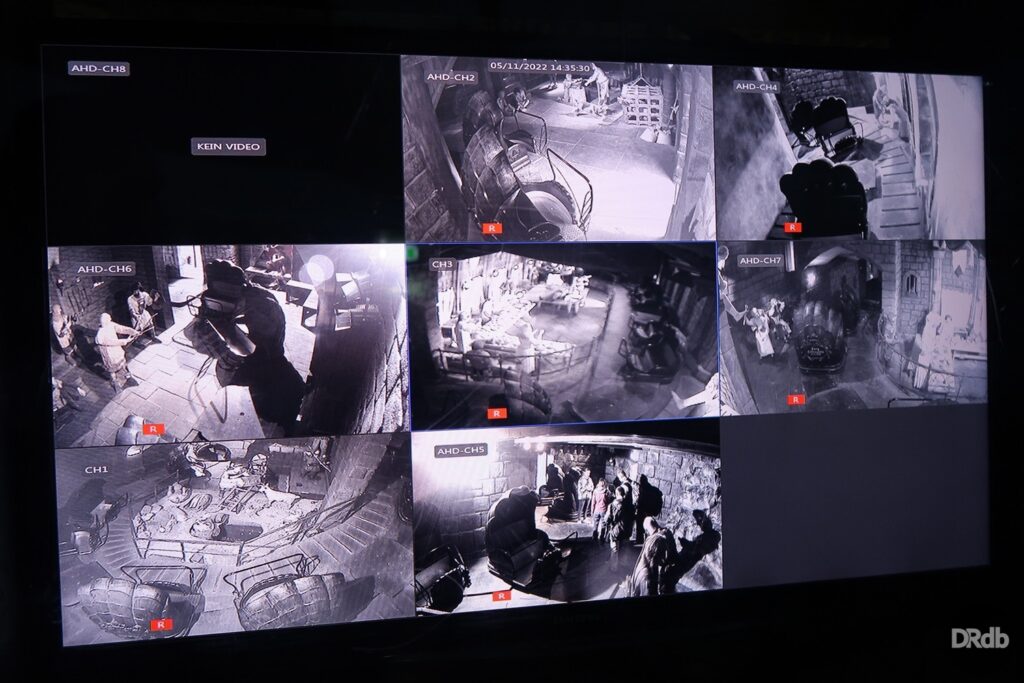
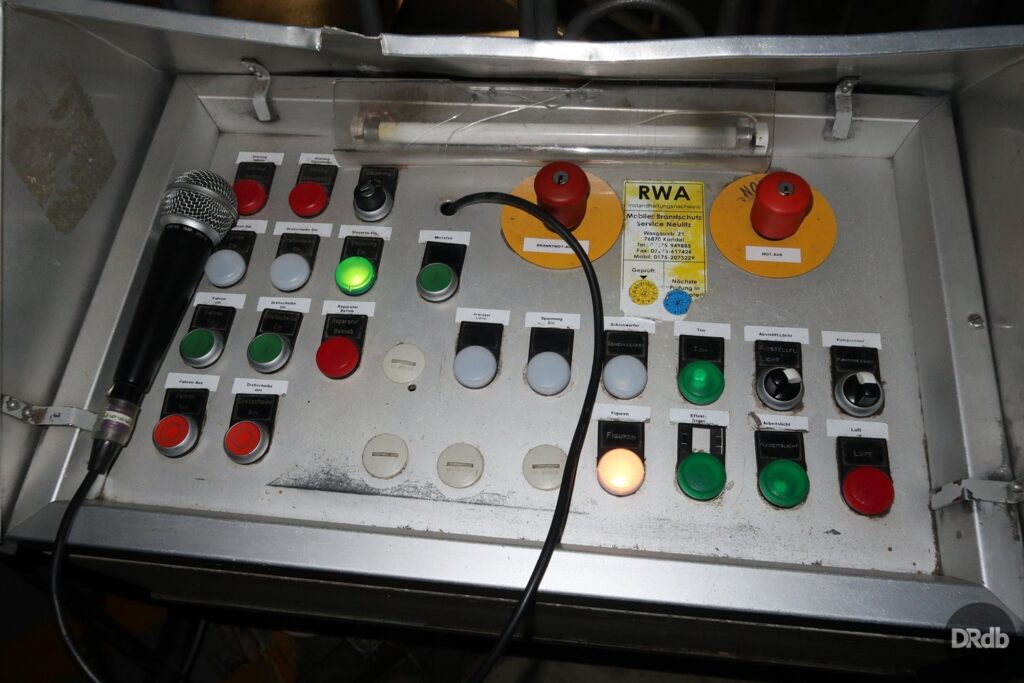
Walking all the way round the station, still going against the traffic, we arrived at the final scene, the treasure room. It is guarded by the ‘Übergroßer Drache‘ (‘Overly large dragon’), a 3 metre high dragon with glowing eyes of which only its upper half can be seen coming out of the floor. In its right claw it’s holding a treasure chest attached to a rope. Around the corner, knights are pulling on the rope, but obviously they’re no match for the dragon. With its other claw it has destroyed one of the burg’s support beams. In the corner to the right, a tall, slender tail emerges from between the treasures.

Behind the beast, large subwoofers lie on the ground to create the growling sound effects which for good measure Jan-Philipp activates right as we’re standing next to it. A smoke installation can also be found here, which has long been put out of commission. A small door on the back of the dragon’s head provides access to the inside through which we learn that the animal is quite the airhead. To create the glowing eyes effect, simple light bulbs are placed right behind the partially translucent pupils, which rapidly change in brightness.
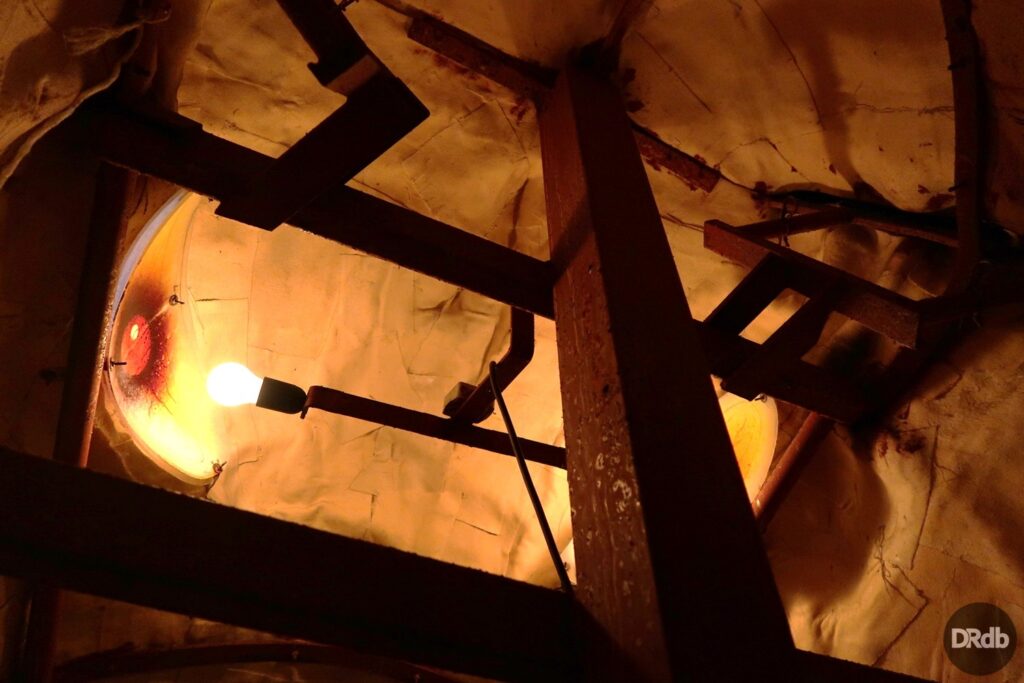
It was time to wave the oversized reptile goodbye and proceed, still in reverse order compared to the usual ride, to the wine cellar. Attackers have overpowered the squires that are working there and have tied them up. One by one, the precious barrels are falling into the hands of the enemy.
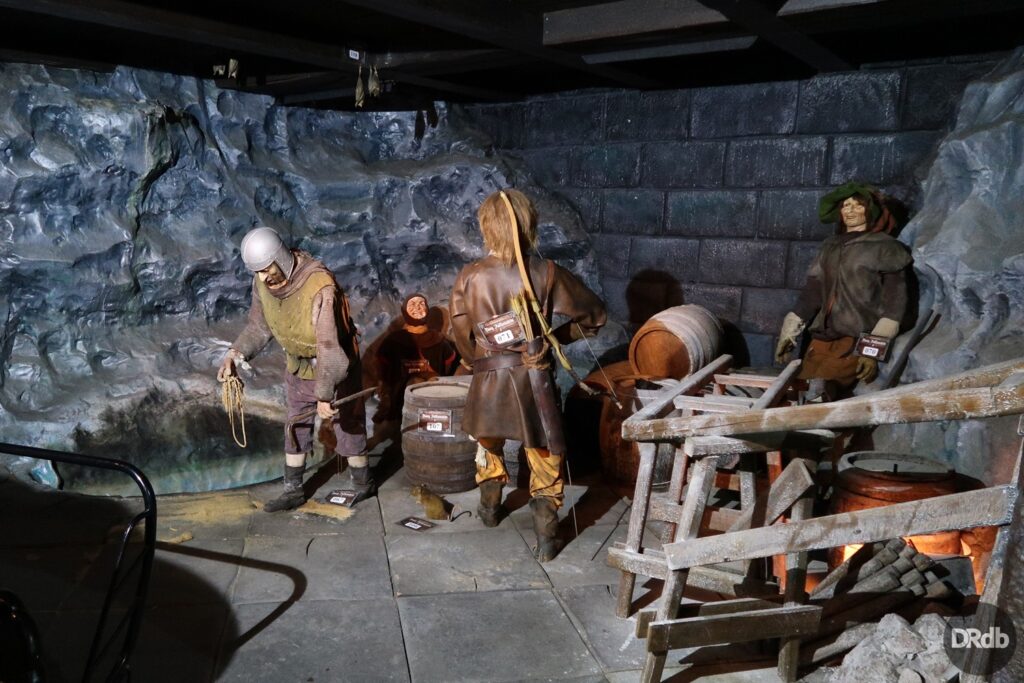
In the next scene, which judging by the stars on the ceiling is supposed to take place in the castle courtyard, they have dug a hole inside of an animal pen through which they can safely escape and take home the goods. Startled chickens and pigs are driven into the corners.
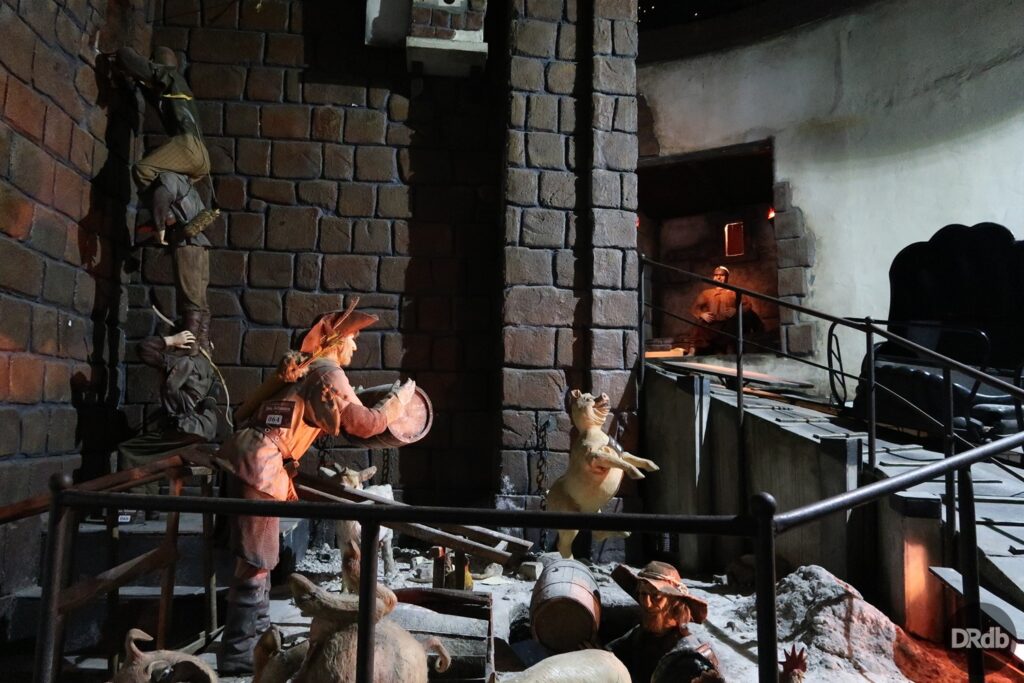
A few of the attackers have formed a human ladder against the large castle wall to peek through a window. ”Can you spot the mistake here?”, askes Jan-Philipp. We’re not sure what he’s talking about. He points to the guy on the bottom of the ladder. ”Somehow, they managed to install that figure facing the wrong way. He is supposed to be leaning against the wall but is now doing so in mid-air. I only noticed this myself last week!”
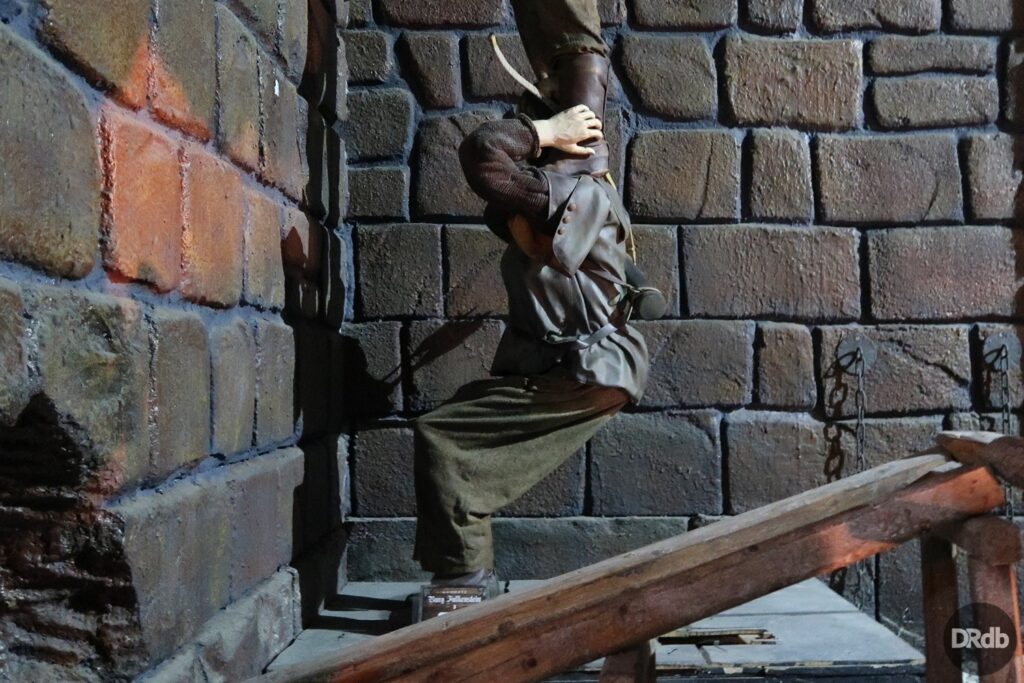
It was time to go upstairs again. We passed by the unpleasant sight of a man stuck on the toilet and ended up in the one scene we had not taken a look at yet. The large Knight’s Hall, with an impressive 27 characters inside, was always one of the most impressive scenes of the ride. In the back wall we can see the window that one of the attackers is peeking through, once again proving that the castle has been designed with great attention to detail.
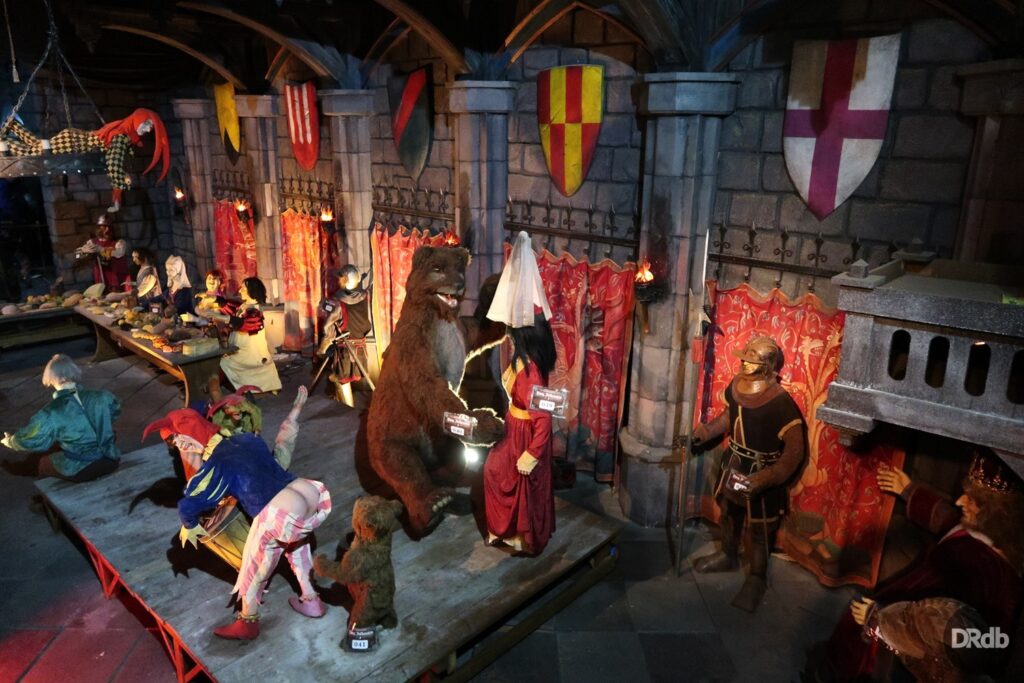
Unbeknown to the plundering going on downstairs, there is a party going on here. Invitees are enjoying a feast at the table as they enjoy a jester who has climbed onto a chandelier. The lord of the castle, surrounded by knights, sits high on his throne, smiling and nodding. A small cheerfully dressed band which is normally playing an annoying song on fanfare trumpet and lute have finally gone silent, giving the couple of villagers close by suffering from hearing damage some well-deserved peace and quiet.
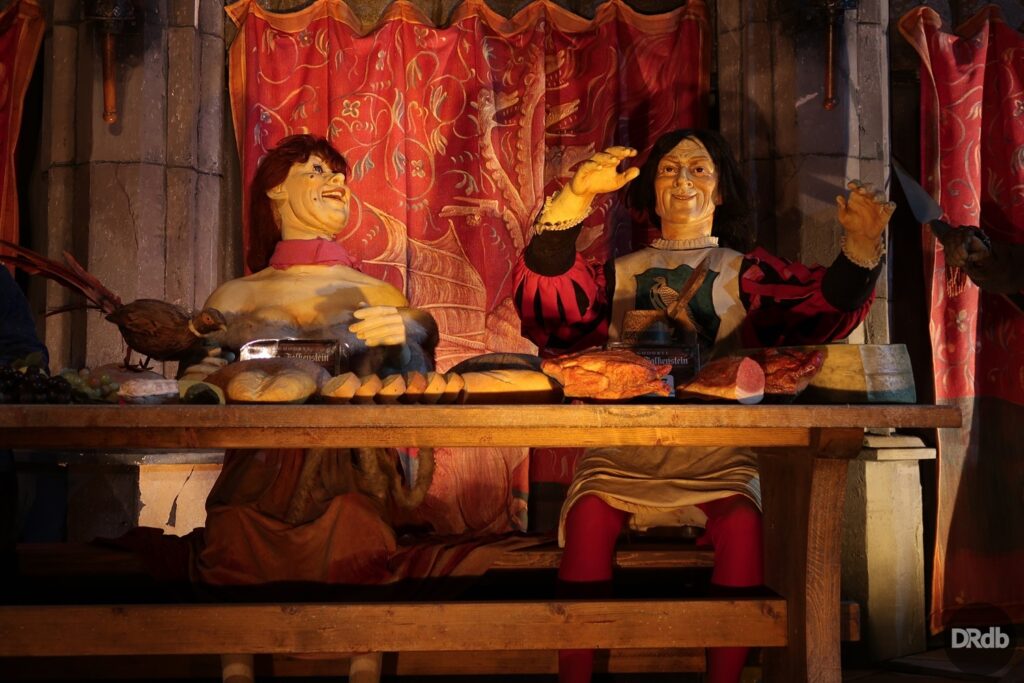
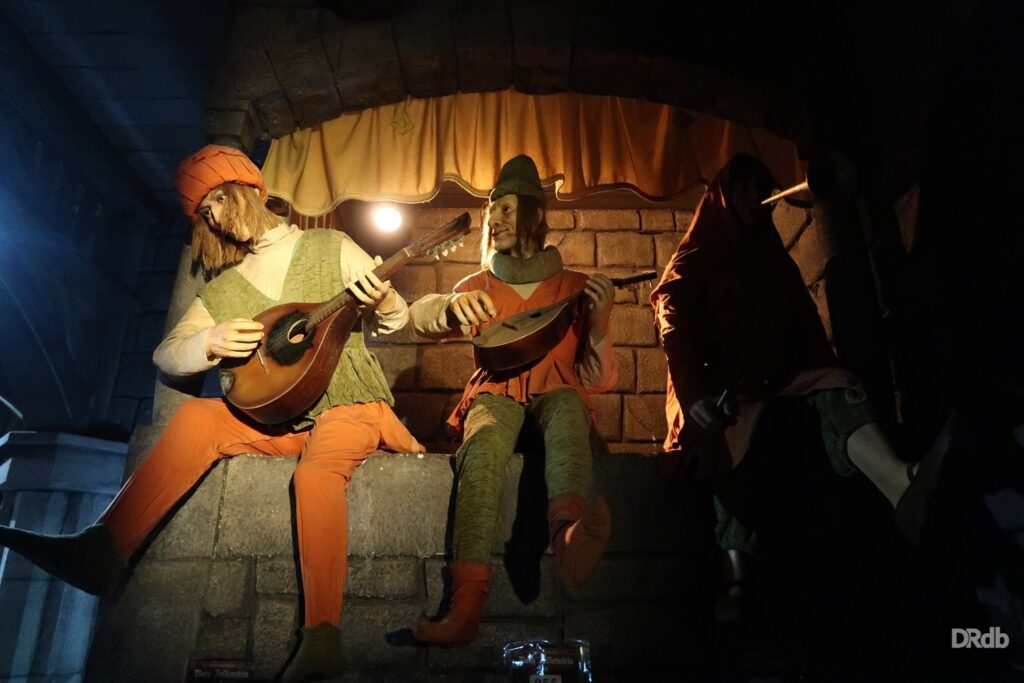
Also this room is very detailed with full theming all around, from the floor to the ceiling. The back wall is covered with shields and curtains depicting dragons. Just one spot is left empty and marked with a plate on the floor. There was originally a bear here that was holding up one of the guests above its head, spinning him around. Jan-Philipp confirms our suspicion that the pair was at one time taken out of the ride for a technical check-up, but was accidentally damaged beyond repair.
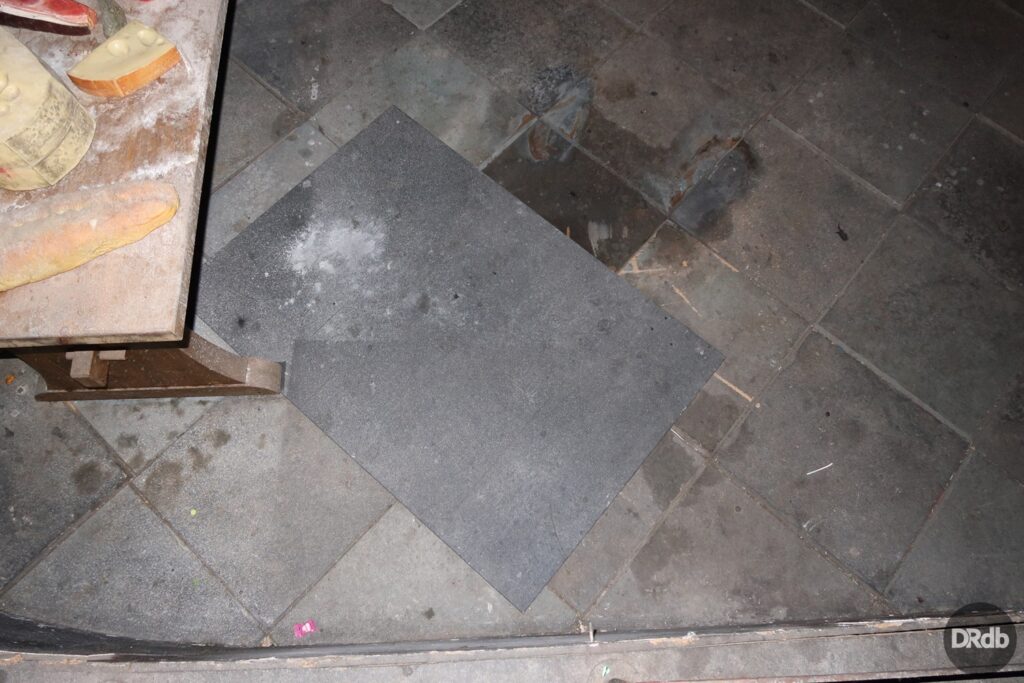
Going backstage
The look in the Knight’s Hall provided a fitting conclusion to the walk through the scenes of Burg Falkenstein, but there was more to look at downstairs. Located centrally at the back of the building, diagonally opposite of the dragon, is a small technical room which houses the show controllers. Large patch cabinets, 4 in total, take up the majority of the available space.
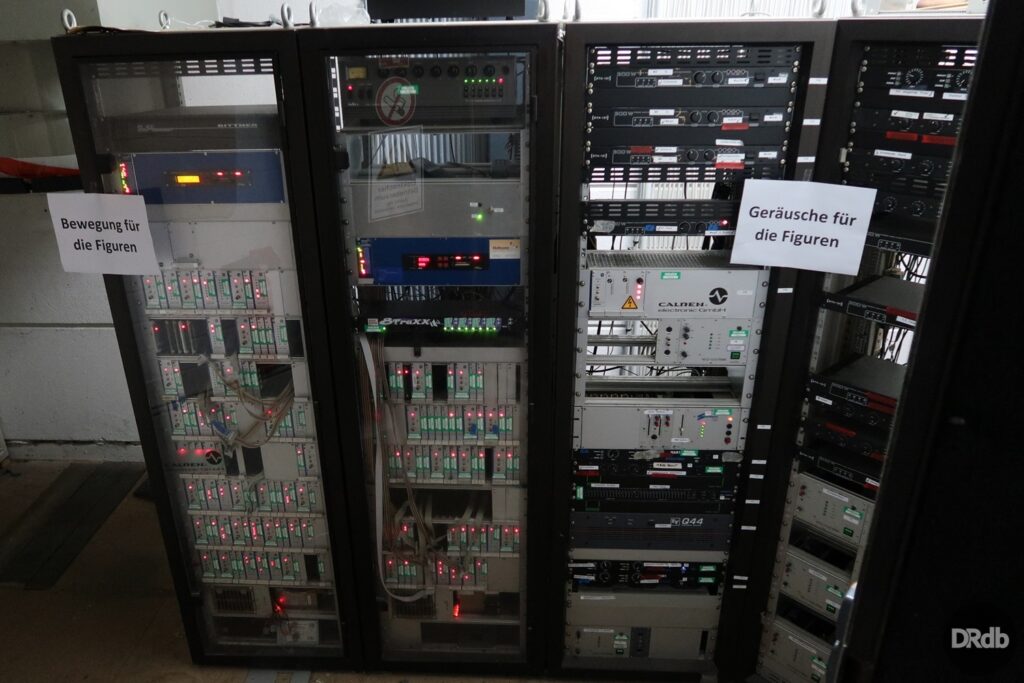
The two cabinets on the left are mainly filled with control boards for the programming of the animatronics. They are these grey cards, manufactured by the German company Calren Electronics. While they are best known for the many soundtracks they produced for Europa-Park, they had a hand in creating show control for dark rides around this time, like the original Piraten in Batavia, which opened the same year as Burg Falkenstein. Calren later went on to manufacture animatronic characters themselves.
There are 3 types of cards, each of which has a scene (and optionally section) number on it to indicate which parts of the castle it controls. These components have never been changed, as evident by the old ”property of Holiday Park” stickers on them, sporting their logo from the 80s.
The first type of cards marked with ‘Mem(ory)’ contain the information for the movements and audio on EEPROM chips, which are used to instruct the other two types of cards. The second type has ‘Motion’ written on them. A total of 8 animatronic functions can be controlled with one of these at once and a light on the front indicates for each function whether or not it is currently being activated.
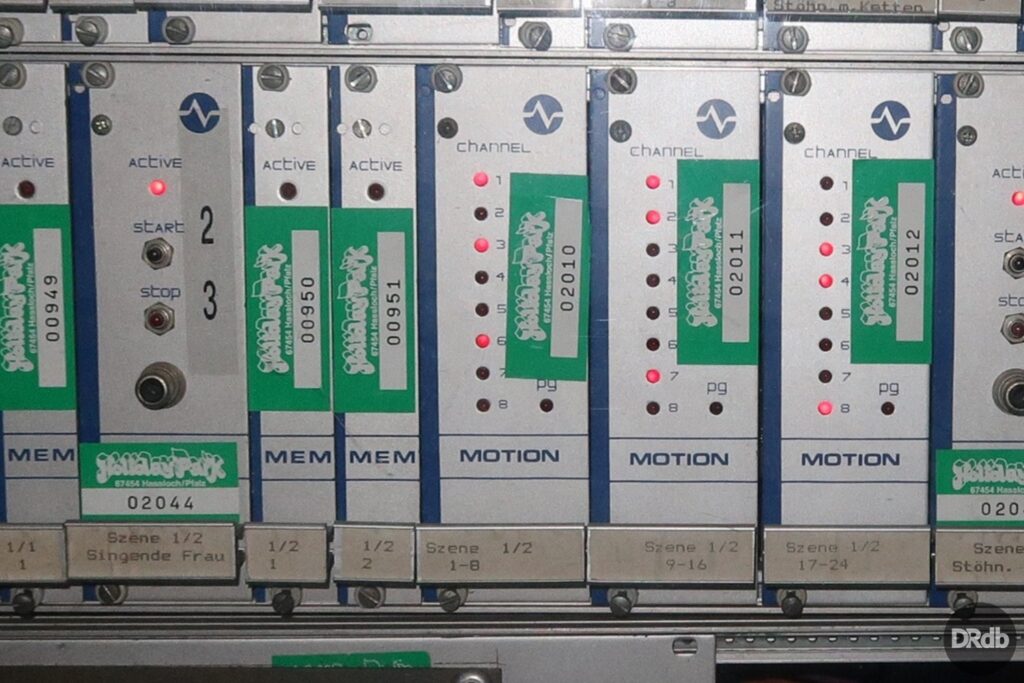
For example, ‘Szene 1/2’ concerns the second section of the first scene, the one with the lady distracting the two guards. 2 memory boards are needed to store the programming and 3 boards with 8 channels each are needed to give the instructions to the animatronics, meaning a total of 24 channels is needed to control this section.
The final type of card, ”Audio”, outputs the audio signals associated and synchronised with the animatronics or other parts of the scenes. They have a start and stop button as well as phono connector output on the front to preview the audio. Because of the limited storage capacity of EEPROMS during that time, the digitally stored samples are of lower quality and had to be kept short. The result was somewhat humorous, as certain sound effects or phrases could be heard over and over again while on the ride.
Additionally, located near the top are 2 original Hofmann Figuren manufactured audio playback units, which pull their data from old school ATA Flash PC Cards, featuring 6 audio files per card. They primarily play general ambience sounds or music in select scenes. ”It was very hard to extract the files from these outdated systems, but we managed to pull it off”, Jan-Philipp explains. A button was also installed later on for switching between the normal and a specialised Halloween soundtrack. During select years, Halloween events were held in the burg, featuring scare actors walking through the decor.
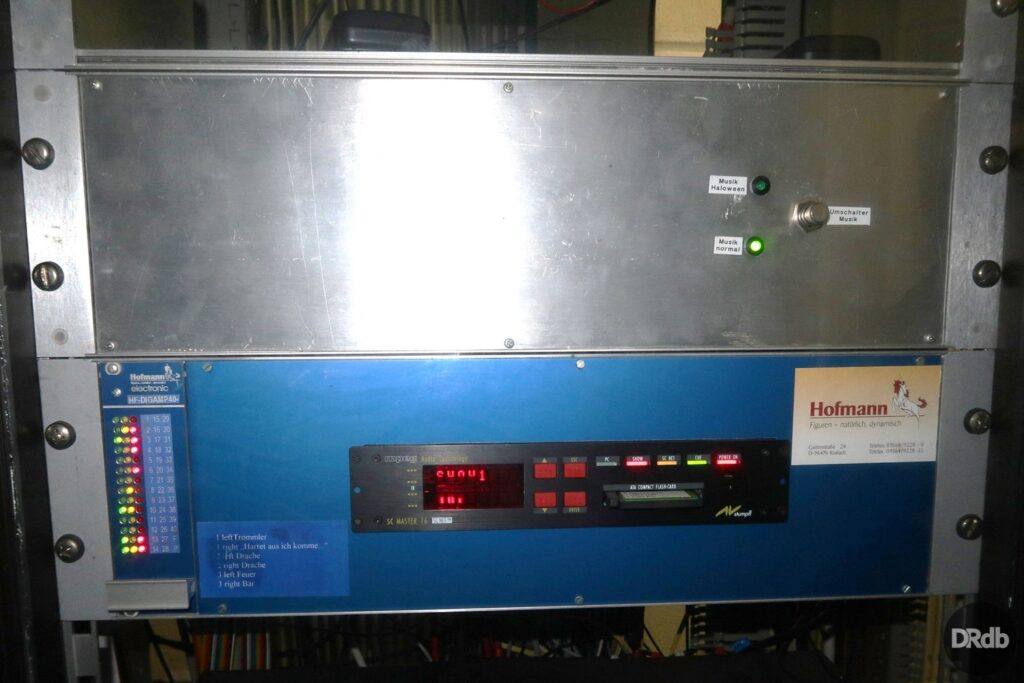
The two cabinets on the right feature even more audio equipment. The grey boxes are original amplifiers by Welü-Elektronik, a company of which we were not able to find any information. Most of these however have been replaced with modern equipment which is smaller, explaining the gaps that have formed in the cabinet.
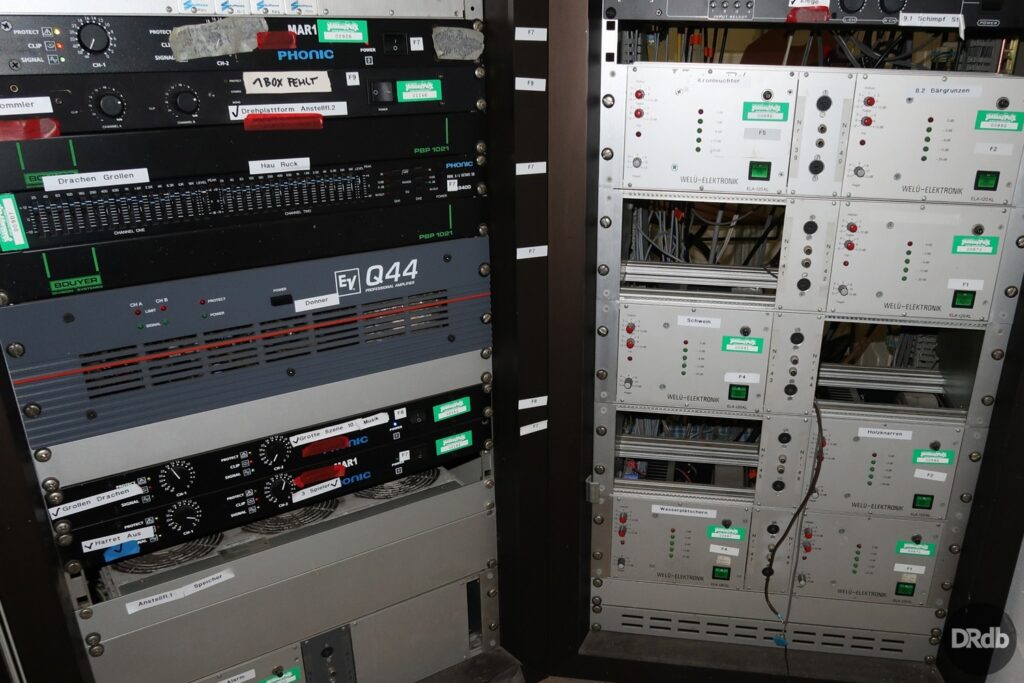
Jan-Philipp points us towards a set of old technical drawings on the wall. They were hand drawn by Heller in early 1987. Even though they have started to fade quite a bit, one can still make out the location of each of the 44 speakers in the castle, all of which play a unique sound effect or piece of music.
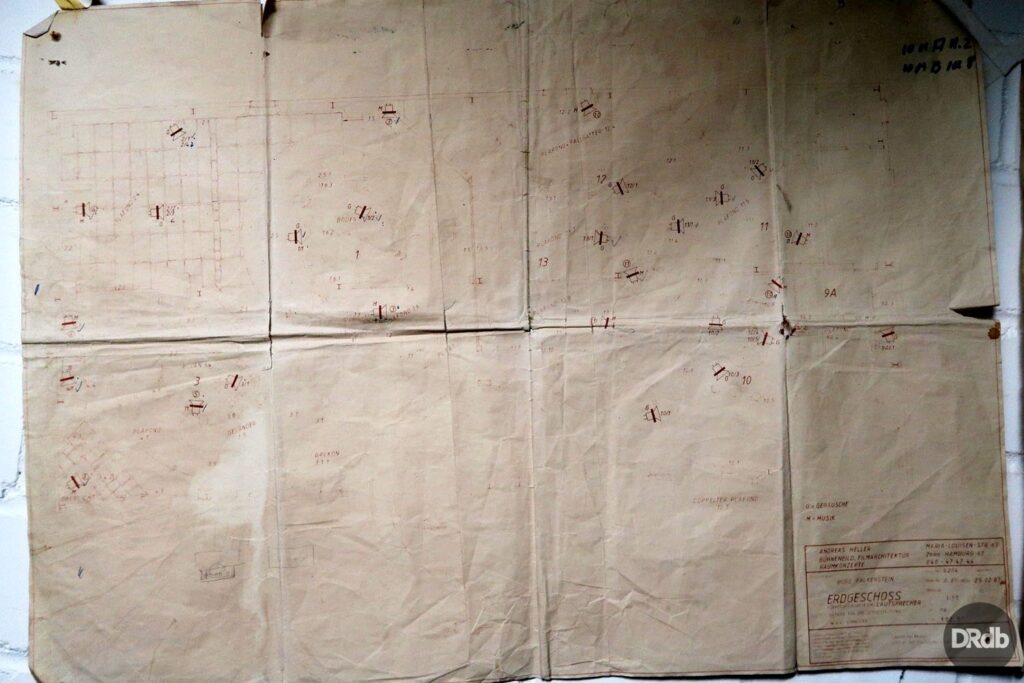
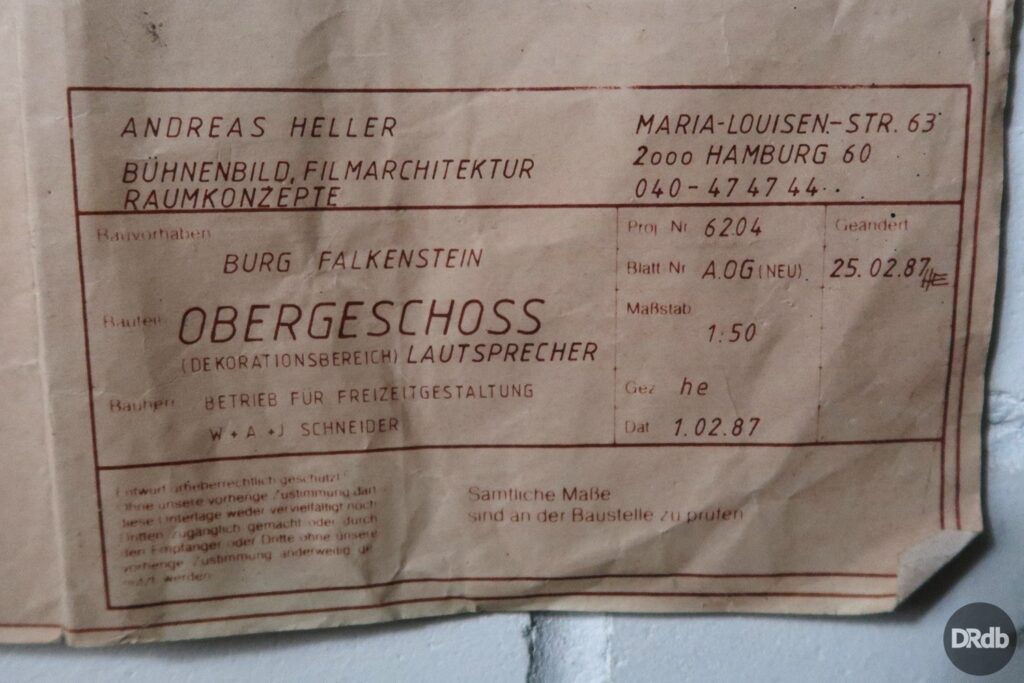
On January 10th 2023, Holiday Park released the original audio files as recorded directly from the 35 year old equipment and put it on SoundCloud for fans to enjoy.
Behind the wine cellar we find a second technical room with dimmer cabinets. The lighting equipment is controlled from here, which was installed by the German firm Steffens Lighting Art, famous for their work on musicals. Over 60 kilometres of cable is needed to power the total of 128 spotlights and 38 other special effects inside Burg Falkenstein. Jan-Philipp shows us an old programming board with which the equipment needed to be manually programmed.
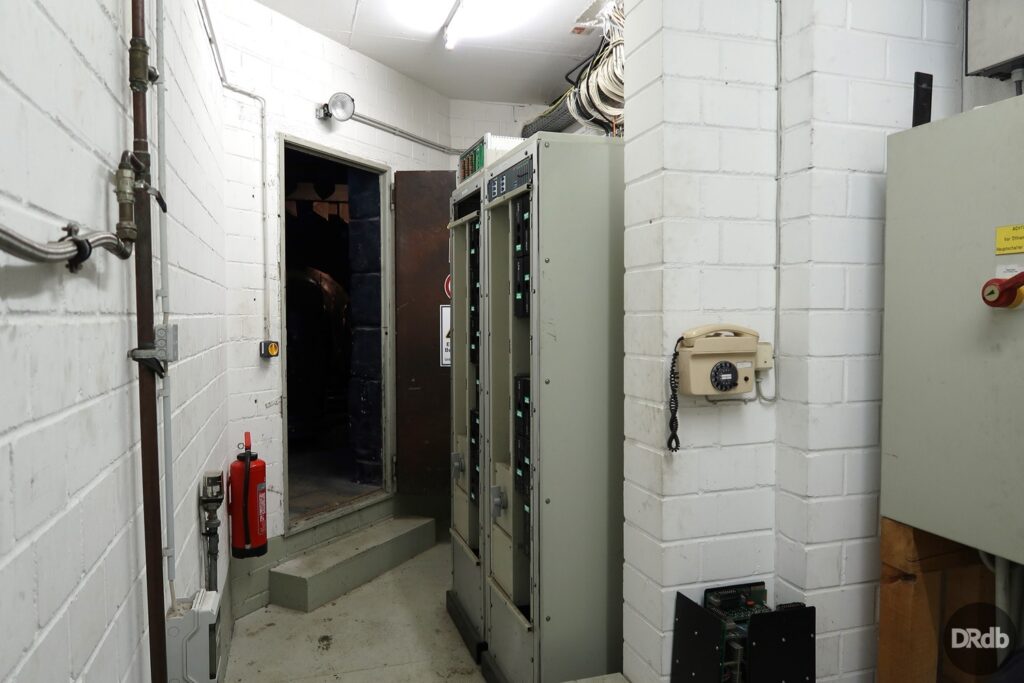
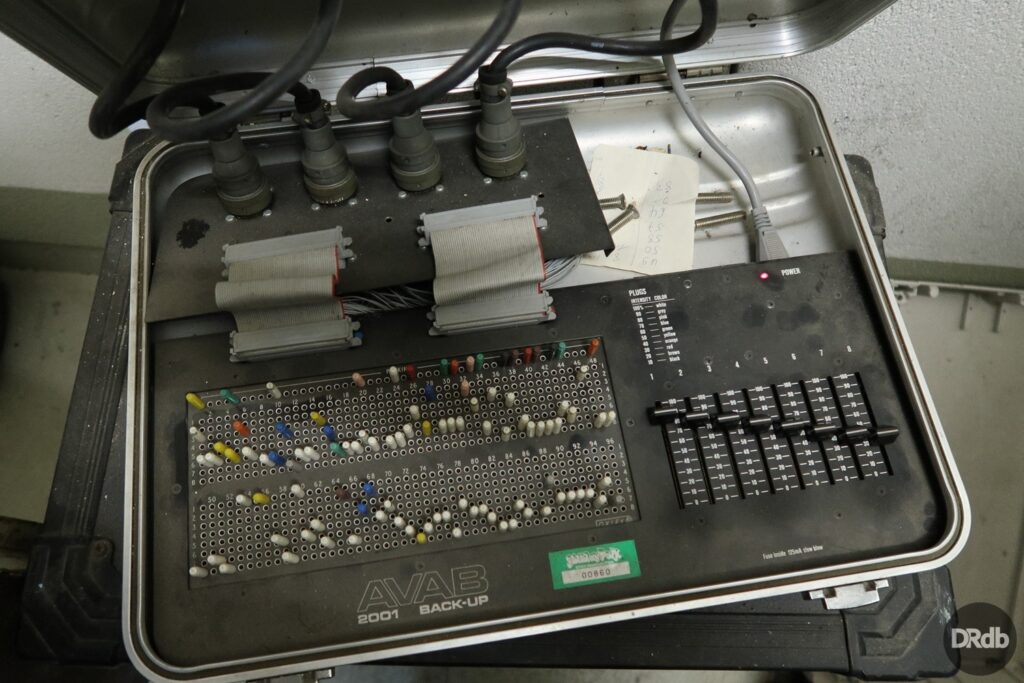
We passed by a map of the ride and turned the corner to take a look at some more appliances. ”The figures of Hofmann are practically indestructible so when they aren’t moving, it’s likely this guy’s fault.” Standing centrally in this room is a large, beat up air compressor. Luckily for us, it’s out of a job now so it can’t torture us with the loud noises it normally makes.
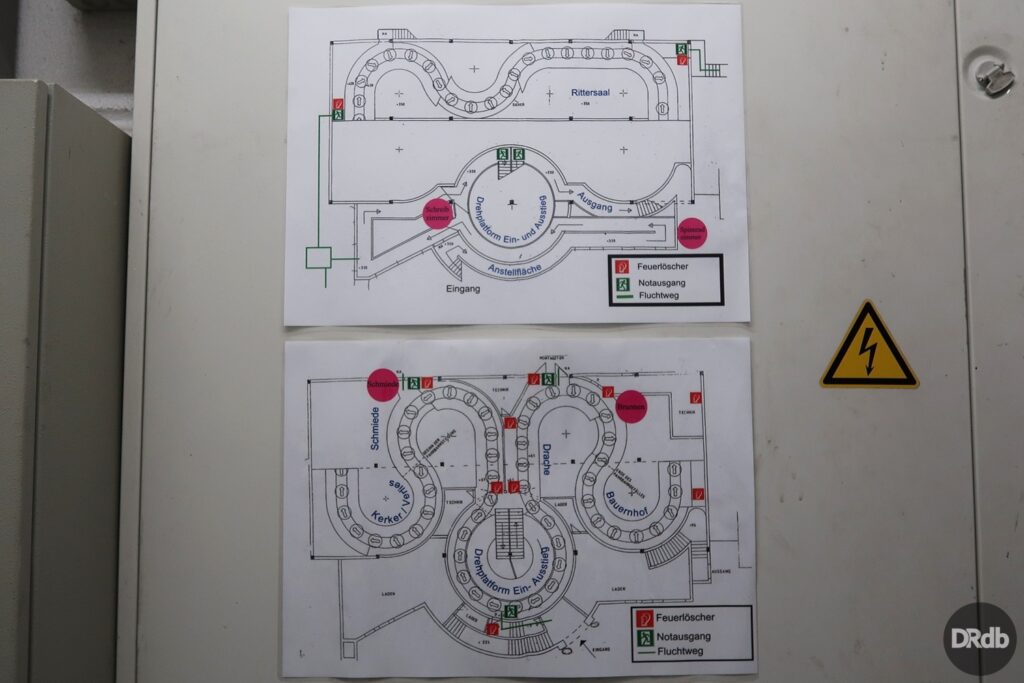
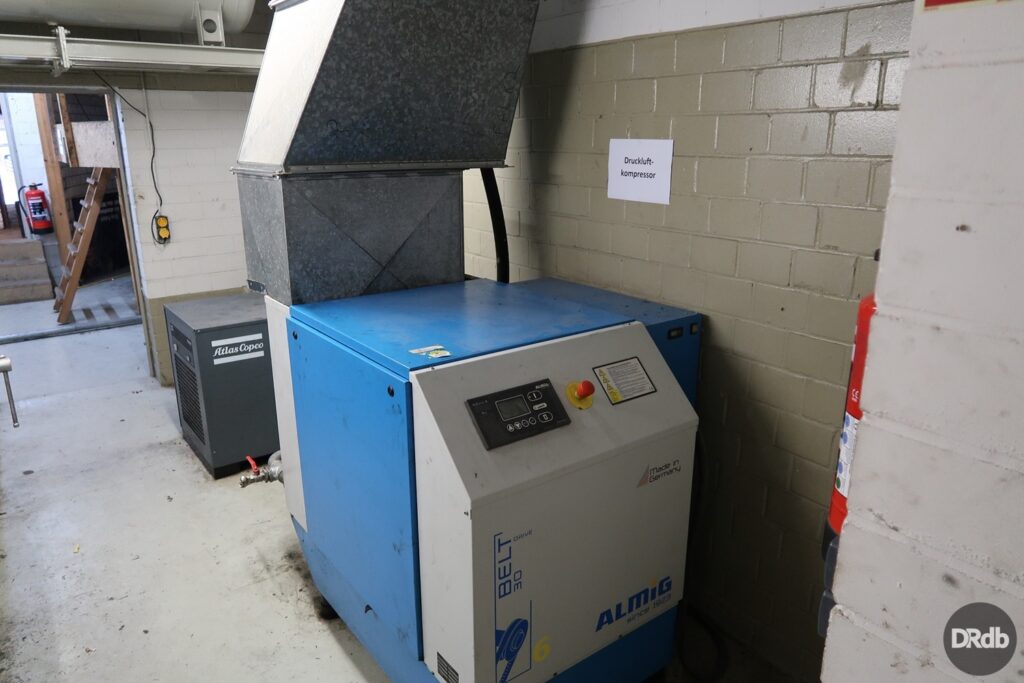
Approximately 5000 m3 air per hour would get pressed through 4500 metre of hose to provide the pneumatic cylinders in the animatronics with the needed pressure to make them move. Located next to it are a dehumidifier and oil pump. A tiny amount of oil is mixed in with the air to automatically lubricate the valves that determine whether or not the cylinder is provided with pressure.
Continuing down this path, we find ourselves underneath the castle courtyard. It’s incredible to see that the massive and heavy looking theming is in reality very light and resting entirely on just some wooden support beams. Here you can also get a clear look at the underside of the Omnimover system. 150 tons of steel were needed to construct it, while the gondolas ride on a total of 1500 wheels.
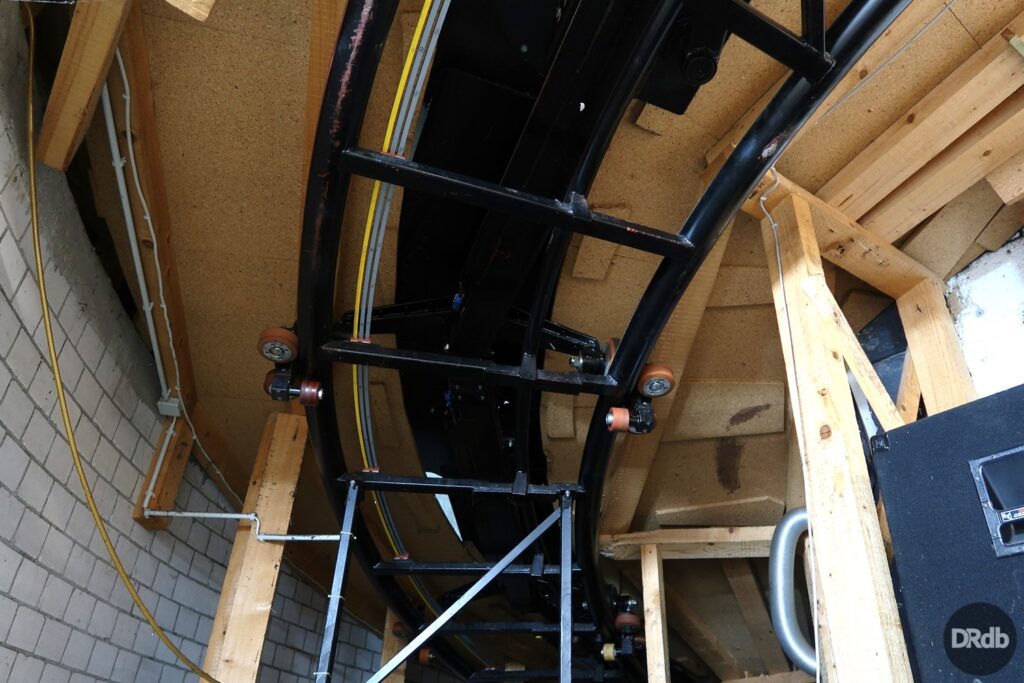
”Every single day before opening, mechanics would spend 1 to 2 hours inside this room, checking all the wheels and gears for possible damages.” It would turn out that the mechanics often forgot their notebooks, because the walls are littered with scribbles. “And yes, it does look like a roller coaster track from down here”, adds Jan-Philipp. A new topic of conversation for those with a never-ending urge to expand their coaster count was thrown into the world during that moment.
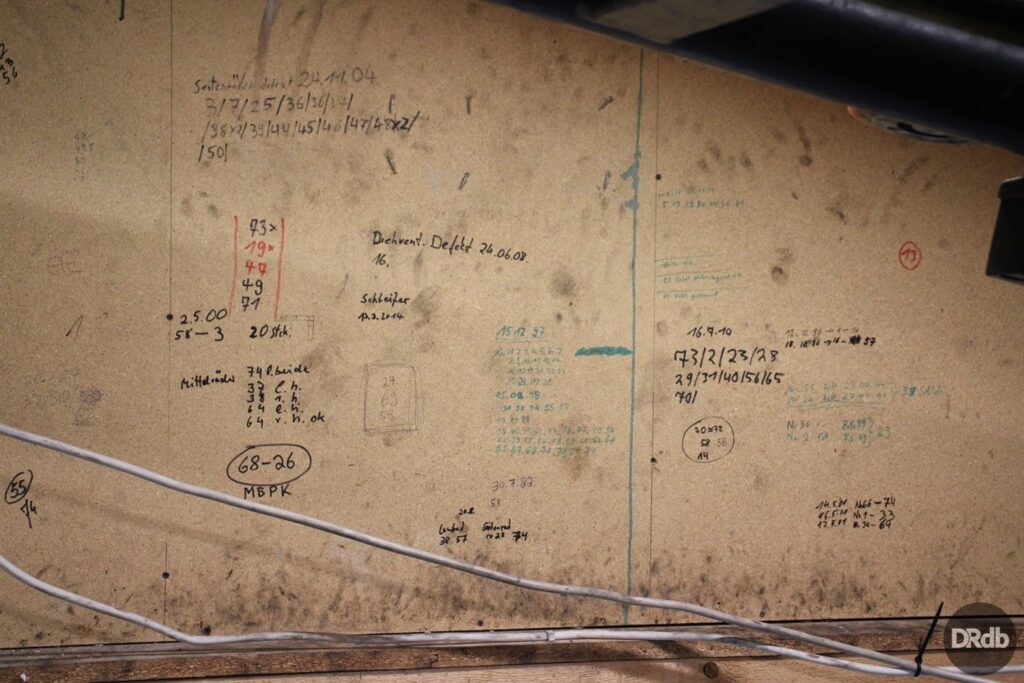
Located down here also is a wind machine that used to make a breeze in the courtyard scene. ”It was a nice effect, because it immediately made it clear to people that the scene takes place outside. That was lost when the machine broke and was never repaired.” One more curiosity caught our eye. In a corner sits part of the original announcement sign that was put up during construction, left to be forgotten after it had served its purpose.
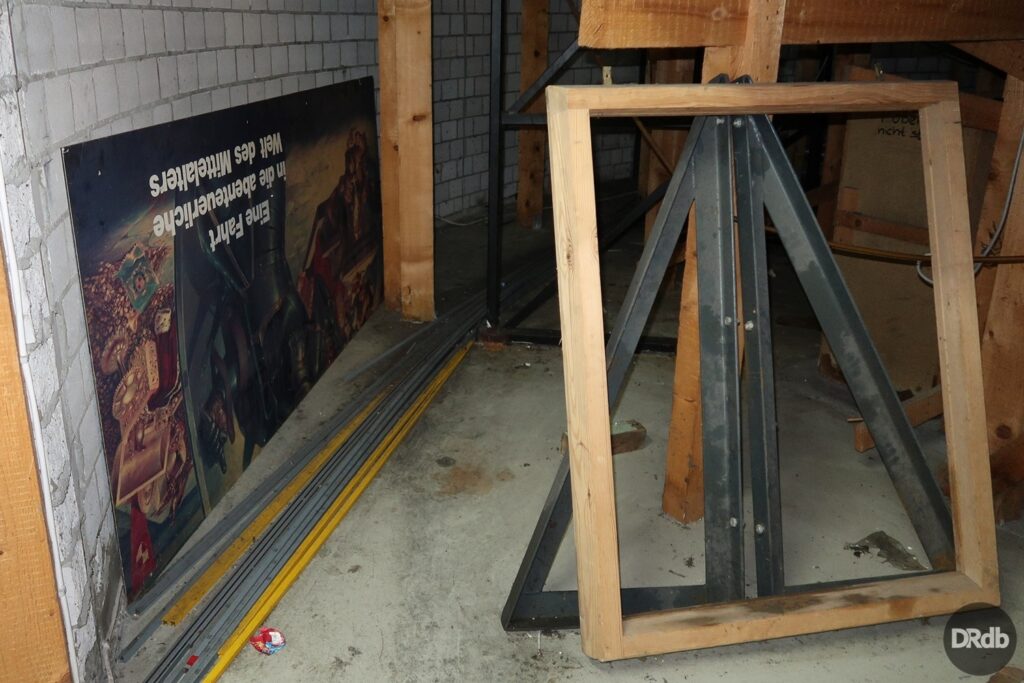
To take a look at how the gondolas move, we have to take a look elsewhere. A portion of the wall in the forge can be taken out to give access to underneath the decor. Down here, a simple electric motor is bolted to the track and powers a wheel that propels the gondolas forward.
The turning is not done electronically, instead a steel beam runs along the entire track, which has slight variations in its position. The gondolas are attached to the beam and a system of gears, 300 in total, convert the position of the beam into the required turning direction. A simple and maintenance free solution, although this brute-force way of turning is likely the cause of the grinding noises Mack’s Omnimovers are known for.
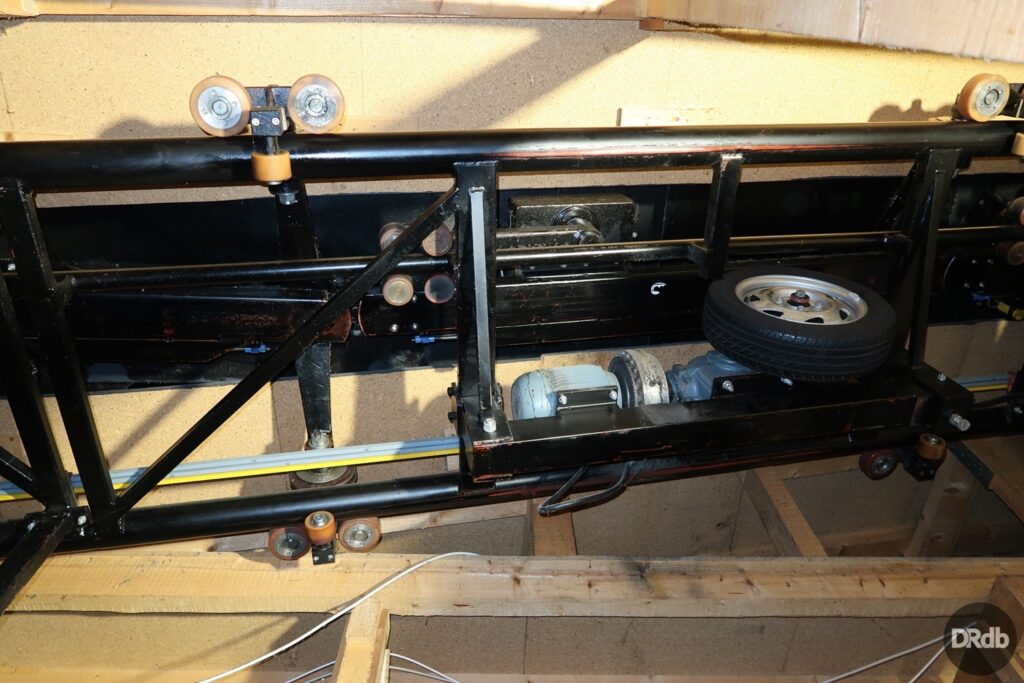
Found in between the first and last of the 47 Omnimover gondolas sits a large air compressor, responsible for automatically closing the safety bars and keeping guests from opening them. It’s a large apparatus, known for its sudden loud noises when the air pressure needs to be raised. The cover had been taken off so we could take a peek inside.
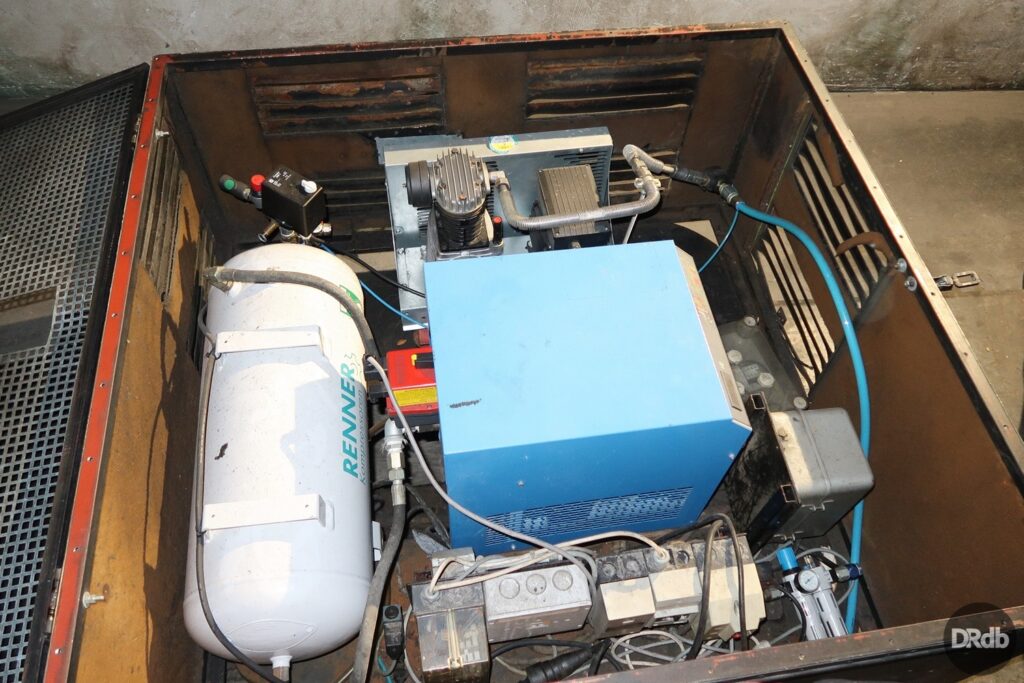
Bolted onto the side is an old plaque from the Heinrich Mack Wagenfabrik, nowadays known as Mack Rides. Like all Mack installations, it has been given a unique identification number, consisting of the last two digits of the year in which their contract was signed followed up with the next available number counting the projects of that year. We can thus conclude that this was the 12th project Mack signed up for during the year 1986.

The future of Burg Falkenstein
By now, we had explored just about every nook and cranny of Burg Falkenstein. We thanked Jan-Philipp for his time and extensive knowledge, so that he could get ready to pick up the next group that was waiting outside. We decided to make one more round through the castle to take some pictures, when we stumbled upon Nick Jespers, Quality Controller at Plopsa Group.
Jespers, a theme park fan himself, was happy to speak with us for a moment. ”It’s impressive that Burg Falkenstein lasted as long as it did, but it really is time for something new. The atmosphere here is so distant from what Plopsa stands for, that it would have taken a lot of effort to try and adjust it. We didn’t want to ruin the ride by taking out certain parts. That’s why we just let it be, but have now decided to start over from the beginning, aside from the transport system. We will also try and re-use as much of the exterior as possible.”

He continues to explain the challenges to overcome with turning Holiday Park into a Plopsa park. ”The Germans are very attached to their classic rides and they weren’t as happy with us ‘foreigners’ taking over Holiday Park. We try to only gradually transform the park, not all at once.” Where possible, references to old rides are kept, like the street signs on the parking. Another example is an old sign from the Teufelsfässer, which is still hidden at Wicky Splash.
As part of the team initiating the Smurfs retheme, Jespers knows all about it: ”We are very proud of our partnership with Studio Peyo, but they are strict in what they do and don’t allow regarding the Smurfs characters.” When asked about the new ride, he explains: ”We don’t have a name for it yet. In fact, the contract was only signed 2 weeks ago, which is why we couldn’t announce the closure of Burg Falkenstein any sooner. Still, we’re not entirely sure what it’s going to look like on the inside, but we’re looking to incorporate interactivity into it.” The ride is likely to feature a mix of screens and physical sets.
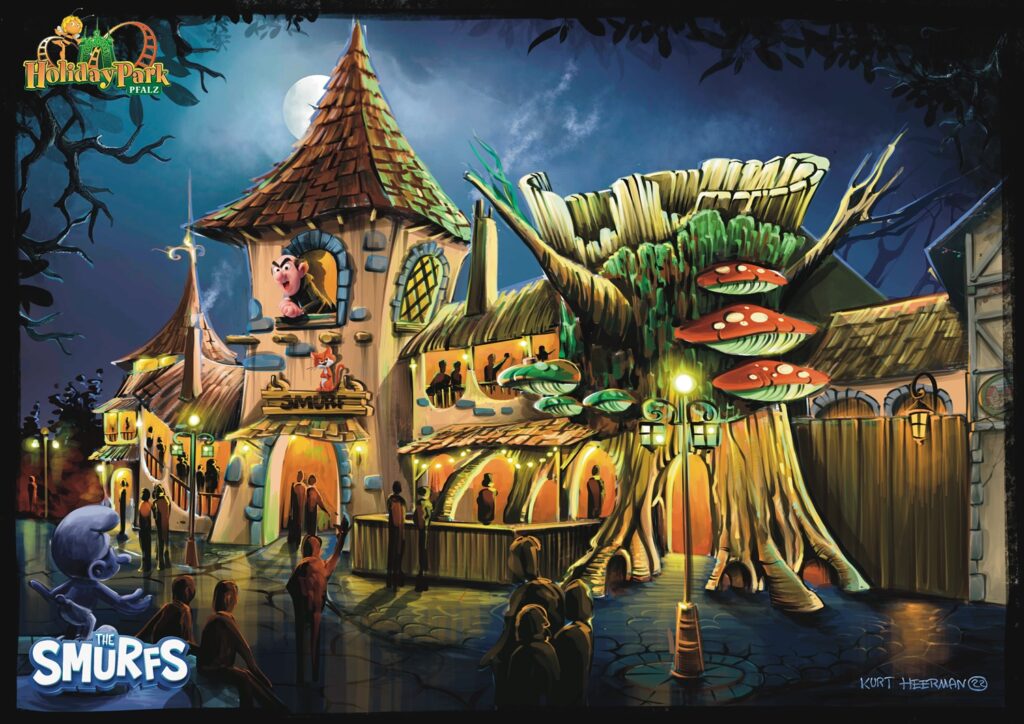
By now it was getting late and time for us to head back home. A tour that was supposed to take about half an hour, ended up lasting over 2 hours thanks to the generous hospitality of Holiday Park. We want to thank Jan-Philipp Reinisch and Nick Jespers for their time and the amazing opportunity to take a look backstage at Burg Falkenstein. We’re looking forward to the opening of the new Smurfs dark ride in 2024!
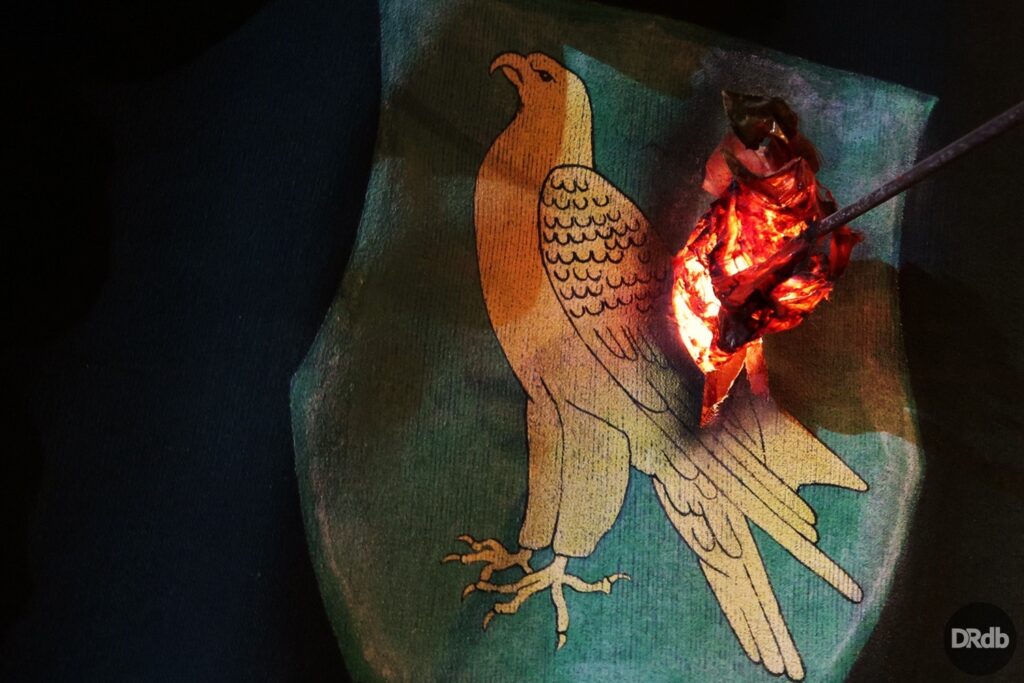
Article and visit by Jim
Pictures © Dark Ride Database unless stated otherwise
Goodbye Burg Falkenstein logo © Holiday Park


